
List of Florida birds
Encyclopedia
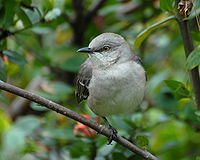
Bird
Birds are feathered, winged, bipedal, endothermic , egg-laying, vertebrate animals. Around 10,000 living species and 188 families makes them the most speciose class of tetrapod vertebrates. They inhabit ecosystems across the globe, from the Arctic to the Antarctic. Extant birds range in size from...
species
Species
In biology, a species is one of the basic units of biological classification and a taxonomic rank. A species is often defined as a group of organisms capable of interbreeding and producing fertile offspring. While in many cases this definition is adequate, more precise or differing measures are...
ever seen in the U.S. state
U.S. state
A U.S. state is any one of the 50 federated states of the United States of America that share sovereignty with the federal government. Because of this shared sovereignty, an American is a citizen both of the federal entity and of his or her state of domicile. Four states use the official title of...
of Florida
Florida
Florida is a state in the southeastern United States, located on the nation's Atlantic and Gulf coasts. It is bordered to the west by the Gulf of Mexico, to the north by Alabama and Georgia and to the east by the Atlantic Ocean. With a population of 18,801,310 as measured by the 2010 census, it...
, as accepted by the Florida Ornithological Society
Florida Ornithological Society
The Florida Ornithological Society is a Florida organization formed to promote field ornithology and facilitate contact between persons interested in birds....
Records Committee (FOSRC) as of 31 December 2010.
The following status codes have been used:
- (I) - IntroducedIntroduced speciesAn introduced species — or neozoon, alien, exotic, non-indigenous, or non-native species, or simply an introduction, is a species living outside its indigenous or native distributional range, and has arrived in an ecosystem or plant community by human activity, either deliberate or accidental...
: Birds that have been introduced to Florida by the actions of man, either directly or indirectly. - (i) - Introduced/nativeIndigenous (ecology)In biogeography, a species is defined as native to a given region or ecosystem if its presence in that region is the result of only natural processes, with no human intervention. Every natural organism has its own natural range of distribution in which it is regarded as native...
: Birds that naturally occur in Florida at certain seasons, or only in parts of the state, but also have populations in Florida that have been introduced by the actions of man, either directly or indirectly. - (E) - ExtinctExtinctionIn biology and ecology, extinction is the end of an organism or of a group of organisms , normally a species. The moment of extinction is generally considered to be the death of the last individual of the species, although the capacity to breed and recover may have been lost before this point...
a recent member of the avifauna that no longer exists. - (A) - Accidental: Birds that occur rarely or accidentally in Florida, and for which the FOSRC requests a full report for verification.
Only birds that are considered to have arrived in Florida without human assistance, or introduced species with established, self-sustaining populations in Florida, are included on this list. Probable escapees are not included. For example, the Ringed Turtle-Dove (Streptopelia "risoria") was previously considered to be an established exotic
Introduced species
An introduced species — or neozoon, alien, exotic, non-indigenous, or non-native species, or simply an introduction, is a species living outside its indigenous or native distributional range, and has arrived in an ecosystem or plant community by human activity, either deliberate or accidental...
; however, although occasional sightings are reported from residential areas, they are probably escapees, and evidence of a true self-sustaining population is lacking. They are, therefore, not included on this list. There are 510 species on the Florida state checklist.
This list includes the Black-hooded Parakeet
Black-hooded Parakeet
The Nanday Parakeet is also known as the Black-hooded Parakeet or Nanday Conure. The bird is native to South America from southeast Bolivia to southwest Brazil, central Paraguay and northern Argentina, from the region known as the pantanal...
, a species which is not on the List of North American birds. This species has been accepted as an introduced exotic by the FOSRC; however, the American Birding Association
American Birding Association
The American Birding Association is a non-profit organization of people interested in birding. Begun in 1968, the ABA is the only organization in North America that specifically caters to recreational birders. Membership is open to all...
has not yet added the species to the "official" North American list.
This list is presented in taxonomic
Taxonomy
Taxonomy is the science of identifying and naming species, and arranging them into a classification. The field of taxonomy, sometimes referred to as "biological taxonomy", revolves around the description and use of taxonomic units, known as taxa...
order and follows The Check-list of North American Birds (7th ed., 51st supplement, 2010), published by the American Ornithologists' Union
American Ornithologists' Union
The American Ornithologists' Union is an ornithological organization in the USA. Unlike the National Audubon Society, its members are primarily professional ornithologists rather than amateur birders...
. The table of contents is grouped into passerine
Passerine
A passerine is a bird of the order Passeriformes, which includes more than half of all bird species. Sometimes known as perching birds or, less accurately, as songbirds, the passerines form one of the most diverse terrestrial vertebrate orders: with over 5,000 identified species, it has roughly...
s (the largest order
Order (biology)
In scientific classification used in biology, the order is# a taxonomic rank used in the classification of organisms. Other well-known ranks are life, domain, kingdom, phylum, class, family, genus, and species, with order fitting in between class and family...
of birds) and non-passerines. The family
Family (biology)
In biological classification, family is* a taxonomic rank. Other well-known ranks are life, domain, kingdom, phylum, class, order, genus, and species, with family fitting between order and genus. As for the other well-known ranks, there is the option of an immediately lower rank, indicated by the...
accounts at the beginning of each heading reflect this taxonomy, as do the species counts found in each family account. Introduced, casual, accidental, extirpated and extinct species are included in the total species counts for North America and Florida.
| Table of contents |
|---|
Non-passerines: Ducks, geese, and swans • Partridges, grouse, turkeys, and Old World quail • New World quail • Loons • Grebes • Flamingoes • Albatrosses • Petrels and shearwaters • Storm-petrels • Tropicbirds • Storks • Frigatebirds • Gannets and boobies • Cormorants • Darters • Pelicans • Bitterns, herons, and egrets • Ibises and spoonbills • New World vultures • Hawks, kites, and eagles • Caracaras and falcons • Rails, gallinules, and coots • Limpkins • Cranes • Lapwings and plovers • Oystercatchers • Stilts and avocets • Sandpipers and allies • Gulls, terns, and skimmers • Skuas • Alcids • Pigeons and doves • Parrots • Cuckoos, roadrunners, and anis • Barn owls • Typical owls • Nightjars • Swifts • Hummingbirds • Kingfishers • Woodpeckers, sapsuckers, and flickers |
Passerines: Tyrant flycatchers • Shrikes • Vireos • Jays, crows, magpies, and ravens • Larks • Swallows and martins • Chickadees and titmice • Nuthatches • Treecreepers • Wrens • Bulbuls • Kinglets • Old World warblers and gnatcatchers • Thrushes • Mimids • Starlings • Pipits • Waxwings • Wood-warblers • Bananaquit • Tanagers • American sparrows, towhees, and juncos • Cardinals, saltators, and grosbeaks • Icterids • Fringilline finches, Cardueline finches, and allies • Old World sparrows • |
Pending See also References External links |
Ducks, geese, and swans
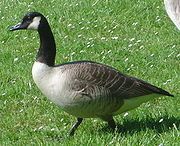
Anseriformes
The order Anseriformes contains about 150 living species of birds in three extant families: the Anhimidae , Anseranatidae , and the Anatidae, which includes over 140 species of waterfowl, among them the ducks, geese, and swans.All species in the order are highly adapted for an aquatic existence at...
. Family: Anatidae
Anatidae
Anatidae is the biological family of birds that includes ducks, geese and swans. The family has a cosmopolitan distribution, occurring on all the world's continents except Antarctica and on most of the world's islands and island groups...
The family Anatidae includes the ducks and most duck-like waterfowl, such as geese and swans. These are birds that are modified for an aquatic existence with webbed feet, flattened bills, and feathers that are excellent at shedding water due to special oils. There are 131 species worldwide, 70 in North America and 42 in Florida.
- Black-bellied Whistling-DuckBlack-bellied Whistling DuckThe Black-bellied Whistling Duck , formerly also called Black-bellied Tree Duck, is a whistling duck that breeds from the southernmost United States and tropical Central to south-central South America. In the USA, it can be found year-round in parts of southeast Texas, and seasonally in southeast...
, Dendrocygna autumnalis - Fulvous Whistling-DuckFulvous Whistling DuckThe Fulvous Whistling Duck, Dendrocygna bicolor, is a whistling duck which breeds across the world's tropical regions in much of Central and South America, Sub-Saharan Africa, the Indian subcontinent, and the Gulf Coast of the United States....
, Dendrocygna bicolor - Greater White-fronted GooseWhite-fronted GooseThe Greater White-fronted Goose is a species of goose. The Greater White-fronted Goose is more closely related to the smaller Lesser White-fronted Goose...
, Anser albifrons - Snow GooseSnow GooseThe Snow Goose , also known as the Blue Goose, is a North American species of goose. Its name derives from the typically white plumage. The genus of this bird is disputed...
, Chen caerulescens - Ross's GooseRoss's GooseThe Ross's Goose is a North American species of goose.The American Ornithologists' Union places this species and the other two "white" geese in the genus Chen rather than the more traditional "grey" goose genus Anser.This goose breeds in northern Canada, mainly in the Queen Maud Gulf Migratory...
, Chen rossii - BrantBrent GooseThe Brant or Brent Goose, Branta bernicla, is a species of goose of the genus Branta. The Black Brant is an American subspecies. The specific descriptor bernicla is from the same source as "barnacle" in Barnacle Goose, which looks similar but is not a close relation.-Appearance:The Brant Goose is...
, Branta bernicla - Cackling GooseCackling GooseThe Cackling Goose is a North American bird of the genus Branta of black geese, which contains species with largely black plumage, distinguishing them from the grey Anser species....
, Branta hutchinsonii (A) - Canada GooseCanada GooseThe Canada Goose is a wild goose belonging to the genus Branta, which is native to arctic and temperate regions of North America, having a black head and neck, white patches on the face, and a brownish-gray body....
, Branta canadensis (i) - Tundra Swan, Cygnus columbianus
- Muscovy DuckMuscovy DuckThe Muscovy Duck is a large duck which is native to Mexico and Central and South America. A small wild population reaches into the United States in the lower Rio Grande Valley of Texas...
, Cairina moschata (I) - Wood DuckWood DuckThe Wood Duck or Carolina Duck is a species of duck found in North America. It is one of the most colourful of North American waterfowl.-Description:...
, Aix sponsa - GadwallGadwallThe Gadwall is a common and widespread duck of the family Anatidae.- Description :The Gadwall is 46–56 cm long with a 78–90 cm wingspan. The male is slightly larger than the female, weighing on average 990 g against her 850 g...
, Anas strepera - Eurasian Wigeon, Anas penelope
- American WigeonAmerican WigeonThe American Wigeon, also American Widgeon or Baldpate, is a species of wigeon in the dabbling duck genus Anas. If this is split up, all wigeons will go into their old genus Mareca again...
, Anas americana - American Black DuckAmerican Black DuckThe American Black Duck is a large dabbling duck. American Black Ducks are similar to Mallards in size, and resemble the female Mallard in coloration, although the Black Duck's plumage is darker...
, Anas rubripes - MallardMallardThe Mallard , or Wild Duck , is a dabbling duck which breeds throughout the temperate and subtropical Americas, Europe, Asia, and North Africa, and has been introduced to New Zealand and Australia....
, Anas platyrhynchos (i) - Mottled DuckMottled DuckThe Mottled Duck or Mottled Mallard is a medium-sized dabbling duck. It is intermediate in appearance between the female Mallard and the American Black Duck. It is closely related to those species, and is sometimes considered a subspecies of the former, but this is inappropriate .There are two...
, Anas fulvigula - Blue-winged TealBlue-winged TealThe Blue-winged Teal is a small dabbling duck from North America.-Description:The Blue-winged Teal is long, with a wingspan of , and a weight of . The adult male has a greyish blue head with a white facial crescent, a light brown body with a white patch near the rear and a black tail. The adult...
, Anas discors - Cinnamon TealCinnamon TealThe Cinnamon Teal is a small, reddish dabbling duck found in marshes and ponds of western North and South America.thumb|left|Female Anas cyanoptera septentrionalium...
, Anas cyanoptera - Northern ShovelerNorthern ShovelerThe Northern Shoveler , Northern Shoveller in British English, sometimes known simply as the Shoveler, is a common and widespread duck. It breeds in northern areas of Europe and Asia and across most of North America, and is a rare vagrant to Australia...
, Anas clypeata - White-cheeked PintailWhite-cheeked PintailThe White cheeked Pintail or Bahama Pintail is a dabbling duck of the Caribbean, South America, and the Galápagos Islands....
, Anas bahamensis (A) - Northern PintailNorthern PintailThe Pintail or Northern Pintail is a widely occurring duck which breeds in the northern areas of Europe, Asia and North America. It is strongly migratory and winters south of its breeding range to the equator...
, Anas acuta - Green-winged TealGreen-winged TealThe Green-winged Teal is a common and widespread duck that breeds in the northern areas of North America except on the Aleutian Islands. It was considered conspecific with the Common Teal The Green-winged Teal (Anas carolinensis) is a common and widespread duck that breeds in the northern areas of...
, Anas crecca carolinensis- Common TealCommon TealThe Eurasian Teal or Common Teal is a common and widespread duck which breeds in temperate Eurasia and migrates south in winter. The Eurasian Teal is often called simply the Teal due to being the only one of these small dabbling ducks in much of its range...
, Anas crecca crecca (A)
- Common Teal
- CanvasbackCanvasbackThe Canvasback is the largest of the North American diving ducks, that ranges from between long and weighs approximately , with a wingspan of . The canvasback has a distinctive wedge-shaped head and long graceful neck. The adult male has a black bill, a chestnut red head and neck, a black...
, Aythya valisineria - RedheadRedhead (duck)The Redhead is a medium-sized diving duck, 37 cm long with an 84 cm wingspan.The adult male has a blue bill, a red head and neck, a black breast, yellow eyes and a grey back. The adult female has a brown head and body and a darker bluish bill with a black tip.The breeding habitat is...
, Aythya americana - Ring-necked DuckRing-necked DuckThe Ring-necked Duck is a smaller diving duck from North America.The adult male is similar in color pattern to the Eurasian Tufted Duck, its relative. It has a grey bill with a white band, a shiny purple head, a white breast, yellow eyes and a dark grey back...
, Aythya collaris - Greater ScaupGreater ScaupThe Greater Scaup , just Scaup in Europe, or colloquially known as "Bluebill", for its bright blue bill, is small compared to other diving ducks, however it is larger than the closely related Lesser Scaup...
, Aythya marila - Lesser ScaupLesser ScaupThe Lesser Scaup is a small North American diving duck that migrates south as far as Central America in winter. It is colloquially known as the Little Bluebill or Broadbill because of its distinctive blue bill...
, Aythya affinis - King EiderKing EiderThe King Eider is a large sea duck that breeds along northern hemisphere Arctic coasts of northeast Europe, North America and Asia. The birds spend most of the year in coastal marine ecosystems at high latitudes, and migrate to Arctic tundra to breed in June and July...
, Somateria spectabilis (A) - Common EiderCommon EiderThe Common Eider, Somateria mollissima, is a large sea-duck that is distributed over the northern coasts of Europe, North America and eastern Siberia. It breeds in Arctic and some northern temperate regions, but winters somewhat farther south in temperate zones, when it can form large flocks on...
, Somateria mollissima - Harlequin DuckHarlequin DuckThe Harlequin Duck is a small sea duck. It takes its name from Arlecchino, Harlequin in French, a colourfully dressed character in Commedia dell'arte. The species name comes from the Latin word "histrio", "actor". In North America it is also known as Lords and ladies...
, Histrionicus histrionicus - Surf ScoterSurf ScoterThe Surf Scoter is a large sea duck, which breeds in Canada and Alaska. It is placed in the subgenus Melanitta, along with the Velvet and White-winged Scoters, distinct from the subgenus Oidemia, Black and Common Scoters.It winters further south in temperate zones, on the coasts of the northern USA...
, Melanitta perspicillata - White-winged ScoterWhite-winged ScoterThe White-winged Scoter is a large sea duck.-Description:It is characterised by its bulky shape and large bill. This is the largest species of scoter. Females range from 950-1950 grams and 48–56 cm , averaging 1180 grams and 52.3 cm . She is brown with pale head patches...
, Melanitta fusca - Black ScoterBlack ScoterThe Black or American Scoter is a large sea duck, 43 to 49 centimeters in length. Together with the Common Scoter M. nigra, it forms the subgenus Oidemia; the two are sometimes considered conspecific, the Black Scoter then being referred to as M. nigra americana...
, Melanitta americana - Long-tailed DuckLong-tailed DuckThe Long-tailed Duck or Oldsquaw is a medium-sized sea duck. It is the only living member of its genus, Clangula; this was formerly used for the goldeneyes, with the Long-tailed Duck being placed in Harelda...
, Clangula hyemalis - BuffleheadBuffleheadThe Bufflehead is a small American sea duck of the genus Bucephala, the goldeneyes. This species was first described by Linnaeus in his Systema naturae in 1758 as Anas albeola.-Description:...
, Bucephala albeola - Common GoldeneyeCommon GoldeneyeThe Common Goldeneye is a medium-sized sea duck of the genus Bucephala, the goldeneyes. Their closest relative is the similar Barrow's Goldeneye....
, Bucephala clangula - Hooded MerganserHooded MerganserThe Hooded Merganser is a small duck and is the only member of the genus Lophodytes.Hooded Mergansers have a crest at the back of the head which can be expanded or contracted. In adult males, this crest has a large white patch, the head is black and the sides of the duck are reddish-brown...
, Lophodytes cucullatus - Common MerganserCommon MerganserThe Common Merganser or Goosander Mergus merganser is a large duck, of rivers and lakes of forested areas of Europe, northern and central Asia, and North America. It eats fish and nests in holes in trees...
, Mergus merganser (A) - Red-breasted MerganserRed-breasted MerganserThe Red-breasted Merganser is a diving duck.-Taxonomy:The Red-breasted Merganser was one of the many species originally described by Linnaeus in his 18th-century work, Systema Naturae.-Description:...
, Mergus serrator - Masked DuckMasked DuckThe Masked Duck is a tiny stiff-tailed duck ranging through the tropical Americas. They are found from Mexico to South America and also in the Caribbean...
, Nomonyx dominicus (A) - Ruddy DuckRuddy DuckThe Ruddy Duck is a small stiff-tailed duck.Their breeding habitat is marshy lakes and ponds throughout much of North America, and in South America in the Andes. They nest in dense marsh vegetation near water. The female builds her nest out of grass, locating it in tall vegetation to hide it from...
, Oxyura jamaicensis
New World quail
Order: GalliformesGalliformes
Galliformes are an order of heavy-bodied ground-feeding domestic or game bird, containing turkey, grouse, chicken, New and Old World Quail, ptarmigan, partridge, pheasant, and the Cracidae. Common names are gamefowl or gamebirds, landfowl, gallinaceous birds or galliforms...
. Family: Odontophoridae
The New World quails are small, plump terrestrial birds only distantly related to the quails of the Old World, but named for their similar appearance and habits. There are 32 species worldwide, all found only in the Americas, including 21 in North America and one in Florida.
- Northern Bobwhite, Colinus virginianus
Partridges, grouse, turkeys, and Old World quail
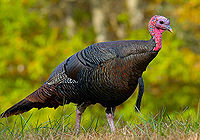
Galliformes
Galliformes are an order of heavy-bodied ground-feeding domestic or game bird, containing turkey, grouse, chicken, New and Old World Quail, ptarmigan, partridge, pheasant, and the Cracidae. Common names are gamefowl or gamebirds, landfowl, gallinaceous birds or galliforms...
. Family: Phasianidae
Phasianidae
The Phasianidae is a family of birds which consists of the pheasants and partridges, including the junglefowl , Old World Quail, francolins, monals and peafowl. The family is a large one, and is occasionally broken up into two subfamilies, the Phasianinae, and the Perdicinae...
The Phasianidae is the family containing the pheasants and their allies. These are terrestrial birds, variable in size but generally plump, with broad, relatively short wings. Many are gamebirds, or have been domesticated as a food source for humans. There are 180 species worldwide, 16 in North America and one in Florida.
- Wild TurkeyWild TurkeyThe Wild Turkey is native to North America and is the heaviest member of the Galliformes. It is the same species as the domestic turkey, which derives from the South Mexican subspecies of wild turkey .Adult wild turkeys have long reddish-yellow to grayish-green...
, Meleagris gallopavo
Loons

Gaviiformes
Gaviiformes is an order of aquatic birds containing the loons or divers and their closest extinct relatives. Modern gaviiformes are found in many parts of North America and northern Eurasia , though prehistoric species were more widespread.-Classification and evolution:There are five living...
. Family: Gaviidae
Loons are aquatic birds the size of a large duck, to which they are unrelated. Their plumage is largely grey or black and they have spear-shaped bills. Loons swim well and fly adequately but, because their legs are placed towards the rear of the body, are clumsy on land. There are five species worldwide, five in North America and three in Florida.
- Red-throated LoonRed-throated DiverThe Red-throated Loon or Red-throated Diver is a migratory aquatic bird found in the northern hemisphere. It breeds primarily in Arctic regions, and winters in northern coastal waters. It is the most widely distributed member of the loon or diver family. Ranging from in length, the Red-throated...
, Gavia stellata - Pacific LoonPacific DiverThe Pacific Loon or Pacific Diver , is a medium-sized member of the loon, or diver, family. It may be conspecific with Black-throated Diver/Arctic Loon, which it closely resembles....
, Gavia pacifica - Common LoonGreat Northern DiverThe Great Northern Loon, Great Northern Diver, or Common Loon , is a large member of the loon, or diver, family of birds...
, Gavia immer
Grebes
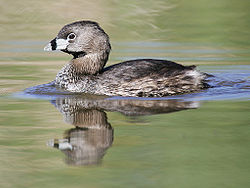
Grebes are small to medium-large sized freshwater diving birds. They have lobed toes and are excellent swimmers and divers. However, they have their feet placed far back on the body, making them quite ungainly on land. There are 20 species worldwide, eight in North America and six in Florida.
- Least GrebeLeast GrebeThe Least Grebe , an aquatic bird, is the smallest member of the grebe family. It occurs in the New World from the southwestern United States and Mexico to Chile and Argentina, and also on Trinidad and Tobago, the Bahamas and the Greater Antilles.-Description:The Least Grebe ranges in length from...
, Tachybaptus dominicus (A) - Pied-billed GrebePied-billed GrebeThe Pied-billed Grebe is a species of the grebe family of water birds. Since the Atitlán Grebe, Podilymbus gigas, has become extinct, it is the sole extant member of the genus Podilymbus.-Description:...
, Podilymbus podiceps - Horned GrebeSlavonian GrebeThe Horned Grebe or Slavonian Grebe, Podiceps auritus, is a member of the grebe family of water birds. The Slavonian Grebe is an excellent swimmer and diver, and pursues its fish prey underwater...
, Podiceps auritus - Red-necked GrebeRed-necked GrebeThe Red-necked Grebe is a migratory aquatic bird found in the temperate regions of the northern hemisphere. Its wintering habitat is largely restricted to calm waters just beyond the waves around ocean coasts, although some birds may winter on large lakes...
, Podiceps grisegena (A) - Eared GrebeBlack-necked GrebeThe Black-necked Grebe, Podiceps nigricollis, known in North America as the Eared Grebe, is a member of the grebe family of water birds. It occurs on every continent except Australia and Antarctica.-Taxonomy:There are three subspecies:*P. n...
, Podiceps nigricollis - Western GrebeWestern GrebeThe Western Grebe, , is a species in the grebe family of water birds. Folk names include "dabchick", "swan grebe" and "swan-necked grebe"....
, Aechmorphorus occidentalis (A)
Flamingoes
Order: Phoenicopteriformes. Family: PhoenicopteridaeFlamingoes are gregarious wading birds, usually 3–5 feet in height, found in both the Western and Eastern Hemispheres. They are more numerous in the latter. Flamingos filter-feed on shellfish and algae. Their oddly-shaped beaks are adapted to separate mud and silt from the food they consume, and are uniquely used upside-down. There are six species worldwide, one in North America and one in Florida.
- American Flamingo, Phoencopterus ruber
Albatrosses
Order: ProcellariiformesProcellariiformes
Procellariiformes is an order of seabirds that comprises four families: the albatrosses, petrels and shearwaters, storm petrels, and diving petrels...
. Family: Diomedeidae
Albatrosses are among the largest of flying
Bird flight
Flight is the main mode of locomotion used by most of the world's bird species. Flight assists birds while feeding, breeding and avoiding predators....
birds, and the great albatrosses from the genus
Genus
In biology, a genus is a low-level taxonomic rank used in the biological classification of living and fossil organisms, which is an example of definition by genus and differentia...
Diomedea have the largest wingspans of any extant birds. There are 21 species worldwide, eight in North America and one in Florida.
- Atlantic Yellow-nosed AlbatrossAtlantic Yellow-nosed AlbatrossThe Atlantic Yellow-nosed Albatross, Thalassarche chlororhynchos, is a large seabird in the albatross family. This small mollymawk was once considered conspecific with the Indian Yellow-nosed Albatross and known as the Yellow-nosed Albatross...
, Thalassarche chlororhynchos (A)
Petrels and shearwaters

Procellariiformes
Procellariiformes is an order of seabirds that comprises four families: the albatrosses, petrels and shearwaters, storm petrels, and diving petrels...
. Family: Procellariidae
Procellariidae
The family Procellariidae is a group of seabirds that comprises the fulmarine petrels, the gadfly petrels, the prions, and the shearwaters. This family is part of the bird order Procellariiformes , which also includes the albatrosses, the storm-petrels, and the diving petrels.The procellariids are...
The procellariids are the main group of medium-sized 'true petrel
Petrel
Petrels are tube-nosed seabirds in the bird order Procellariiformes. The common name does not indicate relationship beyond that point, as "petrels" occur in three of the four families within that group...
s', characterised by united tubular nostril
Nostril
A nostril is one of the two channels of the nose, from the point where they bifurcate to the external opening. In birds and mammals, they contain branched bones or cartilages called turbinates, whose function is to warm air on inhalation and remove moisture on exhalation...
s with a median septum
Septum
In anatomy, a septum is a wall, dividing a cavity or structure into smaller ones.-In human anatomy:...
. There are 75 species worldwide, 35 in North America and eight in Florida.
- Northern FulmarNorthern FulmarThe Northern Fulmar, Fulmarus glacialis, Fulmar, or Arctic Fulmar is a highly abundant sea bird found primarily in subarctic regions of the north Atlantic and north Pacific oceans. Fulmars come in one of two color morphs: a light one which is almost entirely white, and a dark one which is...
, Fulmarus glacialis (A) - Black-capped PetrelBlack-capped PetrelThe Black-capped Petrel is a small seabird in the gadfly petrel genus, Pterodroma. It is also known as the Diablotín. The extinct Jamaica Petrel was a related dark form, often considered a subspecies of this bird.This long-winged petrel has a grey-brown back and wings, with a white nape and rump...
, Pterodoma hasitata - Cory's ShearwaterCory's ShearwaterThe Cory's Shearwater is a large shearwater in the seabird family Procellariidae.This species breeds on islands and cliffs in the Mediterranean, with the odd outpost on the Atlantic coast of Iberia. The nest is on open ground or among rocks or less often in a burrow where one white egg is laid,...
, Calonectris diomedea - Great ShearwaterGreat ShearwaterThe Great Shearwater is a large shearwater in the seabird family Procellariidae. Its relationships are unclear. It belongs in the group of large species that could be separated as genus Ardenna ; within these, it might be allied with the other black-billed, blunt-tailed species Short-tailed...
, Puffinus gravis - Sooty ShearwaterSooty ShearwaterThe Sooty Shearwater is a medium-large shearwater in the seabird family Procellariidae. In New Zealand it is also known by its Māori name tītī and as "muttonbird", like its relatives the Wedge-tailed Shearwater and the Australian Short-tailed Shearwater The Sooty Shearwater (Puffinus griseus) is...
, Puffinus griseus - Short-tailed ShearwaterShort-tailed ShearwaterThe Short-tailed Shearwater or Slender-billed Shearwater , also called Yolla or Moonbird, and commonly known as the muttonbird in Australia, is the most abundant seabird species in Australian waters, and is one of the few Australian native birds in which the chicks are commercially harvested...
, Puffinus tenuirostris (A) - Manx ShearwaterManx ShearwaterThe Manx Shearwater is a medium-sized shearwater in the seabird family Procellariidae. The scientific name of this species records a name shift: Manx Shearwaters were called Manks Puffins in the 17th century. Puffin is an Anglo-Norman word for the cured carcasses of nestling shearwaters...
, Puffinus puffinus (A) - Audubon's ShearwaterAudubon's ShearwaterAudubon's Shearwater, Puffinus lherminieri, is a common tropical seabird from the family Procellariidae. Sometimes called Dusky-backed Shearwater, the scientific name of this species commemorates the French naturalist Félix Louis L'Herminier....
, Puffinus lherminieri
Storm-petrels
Order: ProcellariiformesProcellariiformes
Procellariiformes is an order of seabirds that comprises four families: the albatrosses, petrels and shearwaters, storm petrels, and diving petrels...
. Family: Hydrobatidae
The storm-petrels are the smallest of seabirds, relatives of the petrel
Petrel
Petrels are tube-nosed seabirds in the bird order Procellariiformes. The common name does not indicate relationship beyond that point, as "petrels" occur in three of the four families within that group...
s, feeding on plankton
Plankton
Plankton are any drifting organisms that inhabit the pelagic zone of oceans, seas, or bodies of fresh water. That is, plankton are defined by their ecological niche rather than phylogenetic or taxonomic classification...
ic crustaceans and small fish picked from the ocean's surface, typically while hovering. The flight is fluttering and sometimes bat
Bat
Bats are mammals of the order Chiroptera "hand" and pteron "wing") whose forelimbs form webbed wings, making them the only mammals naturally capable of true and sustained flight. By contrast, other mammals said to fly, such as flying squirrels, gliding possums, and colugos, glide rather than fly,...
-like. There are 21 species worldwide, 15 in North America and three in Florida.
- Wilson's Storm-PetrelWilson's Storm-petrelWilson's Storm Petrel , also known as Wilson's Petrel, is a small seabird of the storm-petrel family. It is one of the most abundant bird species in the world and has a circumpolar distribution mainly in the seas of the southern hemisphere but extending northwards during the summer of the northern...
, Oceanites oceanicus - Leach's Storm-PetrelLeach's Storm-petrelThe Leach's Storm Petrel or Leach's Petrel is a small seabird of the tubenose family. It is named after the British zoologist William Elford Leach....
, Oceanodroma leucorhoa - Band-rumped Storm-Petrel, Oceanodroma castro
Tropicbirds
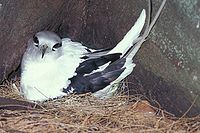
Tropicbirds are slender white birds of tropical oceans, with exceptionally long central tail feathers. Their long wings have black markings, as does the head. There are three species worldwide, three in North America and two in Florida.
- White-tailed TropicbirdWhite-tailed TropicbirdThe White-tailed Tropicbird Phaethon lepturus, is a tropicbird, smallest of three closely related seabirds of the tropical oceans and smallest member of the order Phaethontiformes. It occurs in the tropical Atlantic, western Pacific and Indian Oceans...
, Phaethon lepturus - Red-billed TropicbirdRed-billed TropicbirdThe Red-billed Tropicbird, Phaethon aethereus, also known as the Boatswain Bird is a tropicbird, one of three closely related seabirds of tropical oceans.-Distribution and habitat:...
, Phaeton aethereus (A)
Storks

Ciconiiformes
Traditionally, the order Ciconiiformes has included a variety of large, long-legged wading birds with large bills: storks, herons, egrets, ibises, spoonbills, and several others. Ciconiiformes are known from the Late Eocene...
. Family: Ciconiidae
Storks are large, heavy, long-legged, long-necked wading birds with long stout bills and wide wingspans. They lack the powder down that other wading birds such as herons, spoonbills and ibises use to clean off fish slime. Storks lack a pharynx and are mute. There are 19 species worldwide, two in North America and one in Florida.
- Wood StorkWood StorkThe Wood Stork is a large American wading bird in the stork family Ciconiidae. It was formerly called the "Wood Ibis", though it is not really an ibis.-Appearance:...
, Mycteria americana
Frigatebirds
Order: SuliformesSuliformes
The Order Suliformes is a proposed order by the International Ornithologist's Union...
. Family: Fregatidae
Frigatebirds are large sea-birds usually found over tropical oceans. They are large, black or black and white, with long wings and deeply-forked tails. The males have inflatable coloured throat pouches. They do not swim or walk, and cannot take off from a flat surface. Having the largest wingspan to body weight ratio of any bird, they are essentially aerial, able to stay aloft for more than a week. There are five species worldwide, three in North America and one in Florida.
- Magnificent FrigatebirdMagnificent FrigatebirdThe Magnificent Frigatebird was sometimes previously known as Man O'War, reflecting its rakish lines, speed, and aerial piracy of other birds....
, Fregata magnificens
Gannets and boobies

Suliformes
The Order Suliformes is a proposed order by the International Ornithologist's Union...
. Family: Sulidae
Sulidae
The bird family Sulidae comprises the gannets and boobies. Collectively called sulidas, they are medium-large coastal seabirds that plunge-dive for fish and similar prey. The ten species in this family are often considered congeneric in older sources, placing all in the genus Sula...
The sulids comprise the gannet
Gannet
Gannets are seabirds comprising the genus Morus, in the family Sulidae, closely related to the boobies.The gannets are large black and white birds with yellow heads. They have long pointed wings and long bills. Northern gannets are the largest seabirds in the North Atlantic, with a wingspan of up...
s and boobies
Booby
A booby is a seabird in the genus Sula, part of the Sulidae family. Boobies are closely related to the gannets , which were formerly included in Sula.-Description:...
. Both groups are medium-large coastal seabird
Seabird
Seabirds are birds that have adapted to life within the marine environment. While seabirds vary greatly in lifestyle, behaviour and physiology, they often exhibit striking convergent evolution, as the same environmental problems and feeding niches have resulted in similar adaptations...
s that plunge-dive for fish. There are eight species worldwide, seven in North America and four in Florida.
- Masked BoobyMasked BoobyThe Masked Booby, Sula dactylatra, is a large seabird of the booby family, Sulidae. This species breeds on islands in tropical oceans, except in the eastern Atlantic; in the eastern Pacific it is replaced by the Nazca Booby, Sula granti, which was formerly regarded as a subspecies of Masked Booby...
, Sula dactylatra - Brown BoobyBrown BoobyThe Brown Booby is a large seabird of the booby family, Sulidae. The adult brown booby reaches about in length. Its head and upper body are covered in dark brown, with the remainder being a contrasting white. The juvenile form is gray-brown with darkening on the head, wings and tail...
, Sula leucogaster - Red-footed BoobyRed-footed BoobyThe Red-footed Booby, Sula sula, is a large seabird of the booby family, Sulidae. As suggested by the name, adults always have red feet, but the colour of the plumage varies. They are powerful and agile fliers, but they are clumsy in takeoffs and landings...
, Sula sula - Northern GannetNorthern GannetThe Northern Gannet is a seabird and is the largest member of the gannet family, Sulidae.- Description :Young birds are dark brown in their first year, and gradually acquire more white in subsequent seasons until they reach maturity after five years.Adults are long, weigh and have a wingspan...
, Morus bassanus
Cormorants
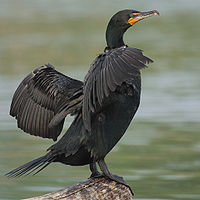
Suliformes
The Order Suliformes is a proposed order by the International Ornithologist's Union...
. Family: Phalacrocoracidae
Cormorants are medium-to-large aquatic birds, usually with mainly dark plumage and areas of coloured skin on the face. The bill is long, thin, and sharply hooked. Their feet are four-toed and webbed, a distinguishing feature among the Pelecaniformes order. There are 41 species worldwide, six in North America and three in Florida.
- Neotropic CormorantNeotropic CormorantThe Neotropic Cormorant or Olivaceous Cormorant is a medium-sized cormorant found throughout the American tropics and subtropics, from the middle Rio Grande and the Gulf and Californian coasts of the USA south through Mexico and Central America to southern South America. It also breeds on the...
, Phalacrocorax brasilianus (A) - Double-crested CormorantDouble-crested CormorantThe Double-crested Cormorant is a member of the cormorant family of seabirds. It occurs along inland waterways as well as in coastal areas, and is widely distributed across North America, from the Aleutian Islands in Alaska down to Florida and Mexico...
, Phalacrocorax auritus - Great CormorantGreat CormorantThe Great Cormorant , known as the Great Black Cormorant across the Northern Hemisphere, the Black Cormorant in Australia and the Black Shag further south in New Zealand, is a widespread member of the cormorant family of seabirds...
, Phalacrocorax carbo
Darters
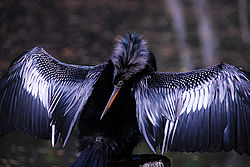
Suliformes
The Order Suliformes is a proposed order by the International Ornithologist's Union...
. Family: Anhingidae
Darters are cormorant-like water birds with very long necks and long, straight beaks. They often swim with only the neck above water, and are fish-eaters. There are four species worldwide, with one in North America.
- AnhingaAnhingaThe Anhinga , sometimes called Snakebird, Darter, American Darter, or Water Turkey, is a water bird of the warmer parts of the Americas. The word "anhinga" comes from the Brazilian Tupi language and means devil bird or snake bird.It is a cormorant-like bird with an average body length of , a...
, Anhinga anhinga
Pelicans
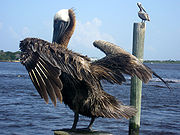
Pelecaniformes
The Pelecaniformes is a order of medium-sized and large waterbirds found worldwide. As traditionally—but erroneously—defined, they encompass all birds that have feet with all four toes webbed. Hence, they were formerly also known by such names as totipalmates or steganopodes...
. Family: Pelecanidae
Pelicans are very large water birds with a distinctive pouch under the beak. Like other birds in the order Pelecaniformes, they have four webbed toes. There are eight species worldwide, with two in North America, both of which occur in Florida.
- American White PelicanAmerican White PelicanThe American White Pelican is a large aquatic bird from the order Pelecaniformes. It breeds in interior North America, moving south and to the coasts, as far as Central America, in winter....
, Pelecanus erythrorhynchos - Brown PelicanBrown PelicanThe Brown Pelican is the smallest of the eight species of pelican, although it is a large bird in nearly every other regard. It is in length, weighs from and has a wingspan from .-Range and habits:...
, Pelecanus occidentalis
Bitterns, herons, and egrets

Ciconiiformes
Traditionally, the order Ciconiiformes has included a variety of large, long-legged wading birds with large bills: storks, herons, egrets, ibises, spoonbills, and several others. Ciconiiformes are known from the Late Eocene...
. Family: Ardeidae
The family Ardeidae contains the herons, egrets, and bitterns. Herons and Egrets are medium to large sized wading birds with long necks and legs. Bitterns tend to be shorter necked and more secretive. Unlike other long-necked birds such as storks, ibises and spoonbills, members of the Ardeidae fly with their necks retracted. There are 61 species worldwide, 28 in North America and 12 in Florida.
- American BitternAmerican BitternThe American Bittern is a wading bird of the heron family Ardeidae. New evidence has led the American Ornithologists' Union to move the heron family into the order Pelecaniformes .-Description:...
, Botaurus lentiginosus - Least BitternLeast BitternThe Least Bittern is a small wading bird, the smallest heron found in the Americas.This bird's underparts and throat are white with light brown streaks. Their face and the sides of the neck are light brown; they have yellow eyes and a yellow bill. The adult male is glossy greenish black on the...
, Ixobrychus exilis - Great Blue HeronGreat Blue HeronThe Great Blue Heron is a large wading bird in the heron family Ardeidae, common near the shores of open water and in wetlands over most of North and Central America as well as the West Indies and the Galápagos Islands. It is a rare vagrant to Europe, with records from Spain, the Azores and England...
, Ardea herodias - Great EgretGreat EgretThe Great Egret , also known as the Great White Egret or Common Egret, White Heron, or Great White Heron, is a large, widely-distributed egret. Distributed across most of the tropical and warmer temperate regions of the world, in southern Europe it is rather localized...
, Ardea alba - Snowy EgretSnowy EgretThe Snowy Egret is a small white heron. It is the American counterpart to the very similar Old World Little Egret, which has established a foothold in the Bahamas....
, Egretta thula - Little Blue HeronLittle Blue HeronThe Little Blue Heron, Egretta caerulea, is a small heron. It breeds from the Gulf states of the USA through Central America and the Caribbean south to Peru and Uruguay. It is a resident breeder in most of its range, but some northern breeders migrate to the southeastern USA or beyond in winter...
, Egretta caerulea - Tricolored HeronTricolored HeronThe Tricolored Heron formerly known in North America as the Louisiana Heron, is a small heron. It is a resident breeder from the Gulf states of the USA and northern Mexico south through Central America and the Caribbean to central Brazil and Peru...
, Egretta tricolor - Reddish EgretReddish EgretThe Reddish Egret is a small heron. It is a resident breeder in Central America, The Bahamas, the Caribbean, the Gulf Coast of the United States, and Mexico. There is post-breeding dispersal to well north of the nesting range...
, Egretta rufescens - Cattle EgretCattle EgretThe Cattle Egret is a cosmopolitan species of heron found in the tropics, subtropics and warm temperate zones. It is the only member of the monotypic genus Bubulcus, although some authorities regard its two subspecies as full species, the Western Cattle Egret and the Eastern Cattle Egret...
, Bubulcus ibis - Green HeronGreen HeronThe Green Heron is a small heron of North and Central America. It was long considered conspecific with its sister species the Striated Heron , and together they were called "Green-backed Heron"...
, Butorides virescens - Black-crowned Night-HeronBlack-crowned Night HeronThe Black-crowned Night Heron commonly abbreviated to just Night Heron in Eurasia, is a medium-sized heron found throughout a large part of the world, except in the coldest regions and Australasia .-Description:Adults are...
, Nycticorax nycticorax - Yellow-crowned Night-HeronYellow-crowned Night HeronThe Yellow-crowned Night Heron , also called the American Night Heron or squawk, is a fairly small heron, similar in appearance to the Black-crowned Night Heron...
, Nyctanassa violacea
Ibises and spoonbills
Order: CiconiiformesCiconiiformes
Traditionally, the order Ciconiiformes has included a variety of large, long-legged wading birds with large bills: storks, herons, egrets, ibises, spoonbills, and several others. Ciconiiformes are known from the Late Eocene...
. Family: Threskiornithidae
Threskiornithidae
The family Threskiornithidae includes 34 species of large terrestrial and wading birds, falling into two subfamilies, the ibises and the spoonbills. It was formerly known as Plataleidae. The spoonbills and ibises were once thought to be related to other groups of long-legged wading birds in the...
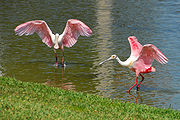
- American White IbisAmerican White IbisThe American White Ibis is a species of wading bird in the ibis family Threskiornithidae. It occurs from the mid-Atlantic and Gulf coast of the United States south through most of the New World tropics...
, Eudocimus albus - Scarlet IbisScarlet IbisThe Scarlet Ibis is a species of ibis that inhabits tropical South America and also Trinidad and Tobago. It is the national bird of Trinidad and is featured on the Trinidad and Tobago coat of arms along with Tobago's national bird, the Rufous-vented Chachalaca.-Taxonomy:This species is very...
, Eudocimus ruber (A) - Glossy IbisGlossy IbisThe Glossy Ibis is a wading bird in the ibis family Threskiornithidae.This is the most widespread ibis species, breeding in scattered sites in warm regions of Europe, Asia, Africa, Australia, and the Atlantic and Caribbean region of the Americas...
, Plegadis falcinellus - White-faced IbisWhite-faced IbisThe White-faced Ibis is a wading bird in the ibis family Threskiornithidae.This species breeds colonially in marshes, usually nesting in bushes or low trees. Its breeding range extends from the western USA south through Mexico, as well as from southeastern Brazil and southeastern Bolivia south to...
, Plegadis chihi - Roseate SpoonbillRoseate SpoonbillThe Roseate Spoonbill, Platalea ajaja, is a gregarious wading bird of the ibis and spoonbill family, Threskiornithidae...
, Platalea ajaja
New World vultures
Order: CiconiiformesCiconiiformes
Traditionally, the order Ciconiiformes has included a variety of large, long-legged wading birds with large bills: storks, herons, egrets, ibises, spoonbills, and several others. Ciconiiformes are known from the Late Eocene...
. Family: Cathartidae
New World vultures are not closely related to Old World vultures, but superficially resemble them because of convergent evolution. Like the Old World vultures, they are scavengers; however, unlike Old World vultures, which find carcasses by sight, New World vultures have a good sense of smell with which they locate carcasses. There are seven species worldwide, all found only in the Americas, five in North America and two in Florida.
- Black VultureAmerican Black VultureThe Black Vulture also known as the American Black Vulture, is a bird in the New World vulture family whose range extends from the southeastern United States to Central Chile and Uruguay in South America...
, Coragyps atratus - Turkey VultureTurkey VultureThe Turkey Vulture is a bird found throughout most of the Americas. It is also known in some North American regions as the Turkey Buzzard , and in some areas of the Caribbean as the John Crow or Carrion Crow...
, Cathartes aura
Ospreys
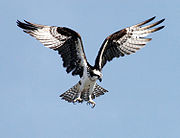
Falconiformes
The order Falconiformes is a group of about 290 species of birds that comprises the diurnal birds of prey. Raptor classification is difficult and the order is treated in several ways.- Classification problems :...
. Family: Pandionidae
The family Pandionidae is a family of fish-eating birds of prey, possessing a very large, powerful hooked beak for tearing flesh from their prey, strong legs, powerful talons, and keen eyesight. The family is monotypic
Monotypic
In biology, a monotypic taxon is a taxonomic group with only one biological type. The term's usage differs slightly between botany and zoology. The term monotypic has a separate use in conservation biology, monotypic habitat, regarding species habitat conversion eliminating biodiversity and...
; its sole member, the Osprey, is found in Florida.
- OspreyOspreyThe Osprey , sometimes known as the sea hawk or fish eagle, is a diurnal, fish-eating bird of prey. It is a large raptor, reaching more than in length and across the wings...
, Pandion haliaetus
Hawks, kites, and eagles
Order: FalconiformesFalconiformes
The order Falconiformes is a group of about 290 species of birds that comprises the diurnal birds of prey. Raptor classification is difficult and the order is treated in several ways.- Classification problems :...
. Family: Accipitridae
Accipitridae
The Accipitridae, one of the two major families within the order Accipitriformes , are a family of small to large birds with strongly hooked bills and variable morphology based on diet. They feed on a range of prey items from insects to medium-sized mammals, with a number feeding on carrion and a...
The family Accipitridae is a family of birds of prey that includes hawks, eagles, kites, harriers and Old World vultures. They have very large, hooked beaks for tearing flesh from their prey, strong legs, powerful talons, and keen eyesight. There are 232 species worldwide, 53 in North America and 18 in Florida.
- Swallow-tailed KiteSwallow-tailed KiteThe Swallow-tailed Kite is an elanid kite which breeds from the southeastern United States to eastern Peru and northern Argentina. Most North and Central American breeders winter in South America where the species is resident year round...
, Elanoides forficatus - White-tailed KiteWhite-tailed KiteThe White-tailed Kite is an elanid kite of genus Elanus found in western North America and parts of South America.Their coloration is gull-like, but their shape and flight falcon-like, with a rounded tail...
, Elanus leucurus - Snail KiteSnail KiteThe Snail Kite is a bird of prey within the family Accipitridae, which also includes the eagles, hawks, and Old World vultures. Its relative, the Slender-billed Kite, is now again placed in Helicolestes, making the genus Rostrhamus monotypic...
, Rostrhamus sociabilis - Mississippi KiteMississippi KiteThe Mississippi Kite is a small bird of prey in the family Accipitridae. It is 12 to 15 inches beak to tail and has a wingspan averaging 3 feet . Weight is from 214 to 388 grams . Adults are gray with darker gray on their tail feathers and outer wings and lighter gray on their heads...
, Ictinia mississippiensis - Bald EagleBald EagleThe Bald Eagle is a bird of prey found in North America. It is the national bird and symbol of the United States of America. This sea eagle has two known sub-species and forms a species pair with the White-tailed Eagle...
, Haliaeetus leucocephalus - Northern Harrier, Circus cyaneus
- Sharp-shinned HawkSharp-shinned HawkThe Sharp-shinned Hawk is a small hawk. In fact, "sharp-shins" or "sharpies" are the smallest to reside in USA and Canada, though some Neotropical species are smaller...
, Accipiter striatus - Cooper's HawkCooper's HawkCooper's Hawk is a medium-sized hawk native to the North American continent and found from Canada to Mexico. As in many birds of prey, the male is smaller than the female...
, Accipiter cooperii - Northern Goshawk, Accipiter gentilis (A)
- Red-shouldered HawkRed-shouldered HawkThe Red-shouldered Hawk is a medium-sized hawk. Its breeding range spans eastern North America and along the coast of California and northern to northeastern-central Mexico.-Description:...
, Buteo lineatus - Broad-winged HawkBroad-winged HawkThe Broad-winged Hawk is a small hawk of the genus Buteo. During the summer some subspecies are distributed over eastern North America, as far west as British Columbia and Texas; they then migrate south to winter in the neotropics from Mexico down to southern Brazil. Other subspecies are all-year...
, Buteo platypterus - Short-tailed HawkShort-tailed HawkThe Short-tailed Hawk is an American bird of prey in the family Accipitridae, which also includes the eagles and Old World vultures. As a member of the genus Buteo, it is not a true hawk and thus also referred to as a "buteo" or "buzzard". The White-throated Hawk The Short-tailed Hawk (Buteo...
, Buteo brachyurus - Swainson's HawkSwainson's HawkThe Swainson's Hawk , is a large buteo hawk of the Falconiformes, sometimes separated in the Accipitriformes like its relatives. This species was named after William Swainson, a British naturalist...
, Buteo swainsoni - Zone-tailed HawkZone-tailed HawkThe Zone-tailed Hawk is a medium-sized hawk of warm, dry parts of the Americas. It feeds on small vertebrates of all kinds , including birds up to the size of quail....
, Buteo albonotatus (A) - Red-tailed HawkRed-tailed HawkThe Red-tailed Hawk is a bird of prey, one of three species colloquially known in the United States as the "chickenhawk," though it rarely preys on standard sized chickens. It breeds throughout most of North America, from western Alaska and northern Canada to as far south as Panama and the West...
, Buteo jamaicensis - Ferruginous HawkFerruginous HawkThe Ferruginous Hawk , Buteo regalis , is a large bird of prey. It is not a true hawk like sparrowhawks or goshawks, but rather belongs to the broad-winged buteo hawks, known as "buzzards" in Europe...
, Buteo regalis (A) - Rough-legged Hawk, Buteo lagopus (A)
- Golden EagleGolden EagleThe Golden Eagle is one of the best known birds of prey in the Northern Hemisphere. Like all eagles, it belongs to the family Accipitridae. Once widespread across the Holarctic, it has disappeared from many of the more heavily populated areas...
, Aquila chrysaetos
Caracaras and falcons
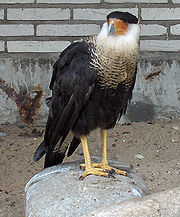
Falconiformes
The order Falconiformes is a group of about 290 species of birds that comprises the diurnal birds of prey. Raptor classification is difficult and the order is treated in several ways.- Classification problems :...
. Family: Falconidae
Falconidae
The falcons and caracaras are around 60 species of diurnal birds of prey that make up the family Falconidae. The family is divided into two subfamiles, Polyborinae, which includes the caracaras and forest falcons, and Falconinae, the falcons, kestrels and falconets.-Description:Falcons and...
The Falconidae
Falconidae
The falcons and caracaras are around 60 species of diurnal birds of prey that make up the family Falconidae. The family is divided into two subfamiles, Polyborinae, which includes the caracaras and forest falcons, and Falconinae, the falcons, kestrels and falconets.-Description:Falcons and...
is a family of diurnal birds of prey containing the falcon
Falcon
A falcon is any species of raptor in the genus Falco. The genus contains 37 species, widely distributed throughout Europe, Asia, and North America....
s and caracara
Caracara
Caracaras are birds of prey in the family Falconidae. They are traditionally placed in the subfamily Polyborinae, but are sometimes considered part of their own subfamily, Caracarinae, or members of the true falcon subfamily, Falconinae...
s. They differ from hawks, eagles, and kites in that they kill with their beaks instead of their feet. There are 62 species worldwide, 19 in North America and five in Florida.
- Northern Caracara, Caracara cheriway
- Eurasian Kestrel, Falco tinnunculus (A)
- American KestrelAmerican KestrelThe American Kestrel , sometimes colloquially known as the Sparrow Hawk, is a small falcon, and the only kestrel found in the Americas. It is the most common falcon in North America, and is found in a wide variety of habitats. At long, it is also the smallest falcon in North America...
, Falco sparverius - MerlinMerlin (bird)The Merlin is a small species of falcon from the Northern Hemisphere. A bird of prey once known colloquially as a pigeon hawk in North America, the Merlin breeds in the northern Holarctic; some migrate to subtropical and northern tropical regions in winter.-European and North American...
, Falco columbarius - Peregrine FalconPeregrine FalconThe Peregrine Falcon , also known as the Peregrine, and historically as the Duck Hawk in North America, is a widespread bird of prey in the family Falconidae. A large, crow-sized falcon, it has a blue-gray back, barred white underparts, and a black head and "moustache"...
, Falco peregrinus
Rails, gallinules, and coots

Gruiformes
The Gruiformes are an order containing a considerable number of living and extinct bird families, with a widespread geographical diversity. Gruiform means "crane-like"....
. Family: Rallidae
Rallidae
The rails, or Rallidae, are a large cosmopolitan family of small to medium-sized birds. The family exhibits considerable diversity and the family also includes the crakes, coots, and gallinules...
The Rallidae is a large family of small to medium-sized birds which includes the rails, crakes, coots, and gallinules. The most typical family members occupy dense vegetation in damp environments near lakes, swamps, or rivers. In general they are shy and secretive, making them difficult to observe. Most have strong legs with long toes, short rounded wings, and are weak fliers. There are 143 species worldwide, 29 in North America and nine in Florida.
- Yellow RailYellow RailThe Yellow Rail, Coturnicops noveboracensis, is a small waterbird, of the family Rallidae.Adults have brown upperparts streaked with black, a yellowish-brown breast, a light belly and barred flanks. The short thick dark bill turns yellow in males during the breeding season. The feathers on the back...
, Coturnicops noveboracensis - Black RailBlack RailThe Black Rail is a mouse-sized member of the Rallidae family of birds. It is found in scattered parts of North America and the Pacific region of South America, usually in coastal salt marshes but also in some freshwater marshes. It is extinct or threatened in many locations due to habitat loss...
, Laterallus jamaicensis - Clapper RailClapper RailThe Clapper Rail is a member of the rail family, Rallidae. Some researchers believe that this bird and the similar King Rail are a single species; the two birds are known to interbreed.-Distribution and habitat:...
, Rallus longirostris - King RailKing RailThe King Rail, Rallus elegans, is a waterbird, the largest North American rail.Distinct features are a long bill with a slight downward curve, with adults being brown on the back and rusty-brown on the face and breast with a dark brown cap. They also have a white throat and a light belly with...
, Rallus elegans - Virginia RailVirginia RailThe Virginia Rail, Rallus limicola, is a small waterbird, of the family Rallidae.Adults are mainly brown, darker on the back and crown, with orange-brown legs. They have long toes, a short tail and a long slim reddish bill...
, Rallus limicola - SoraSora (crake)The Sora is a small waterbird of the family Rallidae, sometimes also referred to as the Sora Rail or Sora Crake.Adults Soras are long, with dark-marked brown upperparts, a blue-grey face and underparts, and black and white barring on the flanks. They have a short thick yellow bill, with black...
, Porzana carolina - Purple GallinuleAmerican Purple GallinuleThe American Purple Gallinule is a "swamp hen" in the rail family Rallidae.A medium-sized rail with big yellow feet, purple-blue plumage with a green back, and red and yellow bill. It has a pale blue forehead shield and white undertail.Juveniles are brown overall with a brownish olive back...
, Porphyrio martinica - Common GallinuleCommon GallinuleThe Common Gallinule, is a North American bird in the Rallidae family which has recently been split from the Common Moorhen by the AOU in July 2011. It lives around well-vegetated marshes, ponds, canals and other wetlands. The species is not found in the polar regions, or many tropical rainforests...
, Gallinula galeata - American CootAmerican CootThe American Coot is a bird of the family Rallidae, inhabiting wetlands and open water bodies. Measuring in length and across the wings, adults have a short thick white bill and white frontal shield, which usually has a reddish-brown spot near the top of the bill between the eyes...
, Fulica americana
Limpkins
Order: GruiformesGruiformes
The Gruiformes are an order containing a considerable number of living and extinct bird families, with a widespread geographical diversity. Gruiform means "crane-like"....
. Family: Aramidae
The Limpkin is an odd bird that looks like a large rail, but is skeletally closer to the cranes
Crane (bird)
Cranes are a family, Gruidae, of large, long-legged and long-necked birds in the order Gruiformes. There are fifteen species of crane in four genera. Unlike the similar-looking but unrelated herons, cranes fly with necks outstretched, not pulled back...
. It is found in marshes with some trees or scrub in the Caribbean
Caribbean
The Caribbean is a crescent-shaped group of islands more than 2,000 miles long separating the Gulf of Mexico and the Caribbean Sea, to the west and south, from the Atlantic Ocean, to the east and north...
, South America
South America
South America is a continent situated in the Western Hemisphere, mostly in the Southern Hemisphere, with a relatively small portion in the Northern Hemisphere. The continent is also considered a subcontinent of the Americas. It is bordered on the west by the Pacific Ocean and on the north and east...
and southern Florida
Florida
Florida is a state in the southeastern United States, located on the nation's Atlantic and Gulf coasts. It is bordered to the west by the Gulf of Mexico, to the north by Alabama and Georgia and to the east by the Atlantic Ocean. With a population of 18,801,310 as measured by the 2010 census, it...
. There is one species worldwide.
- LimpkinLimpkinThe Limpkin , Aramus guarauna, is a bird that looks like a large rail but is skeletally closer to cranes. It is the only extant species in the genus Aramus and the family Aramidae. It is found mostly in wetlands in warm parts of the Americas, from Florida to northern Argentina...
, Aramus guarauna
Cranes

Gruiformes
The Gruiformes are an order containing a considerable number of living and extinct bird families, with a widespread geographical diversity. Gruiform means "crane-like"....
. Family: Gruidae
Cranes are large, long-legged and long-necked birds. Unlike the similar-looking but unrelated herons, cranes fly with necks extended. Most have elaborate and noisy courtship displays or "dances". There are 15 species worldwide, three in North America and two in Florida.
- Sandhill CraneSandhill CraneThe Sandhill Crane is a large crane of North America and extreme northeastern Siberia. The common name of this bird references habitat like that at the Platte River, on the edge of Nebraska's Sandhills in the American Midwest...
, Grus canadensis - Whooping CraneWhooping CraneThe whooping crane , the tallest North American bird, is an endangered crane species named for its whooping sound. Along with the Sandhill Crane, it is one of only two crane species found in North America. The whooping crane's lifespan is estimated to be 22 to 24 years in the wild...
, Grus americana (i)
Lapwings and plovers
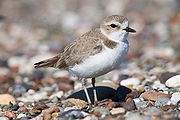
Charadriiformes
Charadriiformes is a diverse order of small to medium-large birds. It includes about 350 species and has members in all parts of the world. Most Charadriiformes live near water and eat invertebrates or other small animals; however, some are pelagic , some occupy deserts and a few are found in thick...
. Family: Charadriidae
Charadriidae
The bird family Charadriidae includes the plovers, dotterels, and lapwings, about 64 to 66 species in all.- Morphology :They are small to medium-sized birds with compact bodies, short, thick necks and long, usually pointed, wings, but most species of lapwing may have more rounded wings...
The family Charadriidae includes the plovers, dotterels, and lapwings. They are small to medium-sized birds with compact bodies, short, thick necks, and long, usually pointed, wings. They are generally found in open country, mostly in habitats near water, although there are some exceptions. There are 66 species worldwide, 18 in North America and eleven in Florida.
- Northern LapwingNorthern LapwingThe Northern Lapwing , also known as the Peewit, Green Plover or just Lapwing, is a bird in the plover family. It is common through temperate Eurasia....
, Vanellus vanellus (A) - Black-bellied Plover, Pluvialis squatarola
- American Golden-PloverAmerican Golden PloverThe American Golden Plover is a medium-sized plover.Adults are spotted gold and black on the crown, back and wings. Their face and neck are black with a white border; they have a black breast and a dark rump. The legs are black....
, Pluviali dominicas - Lesser Sand-PloverLesser Sand PloverThe Lesser Sand Plover, Charadrius mongolus, is a small wader in the plover family of birds. The spelling is commonly given as Lesser Sandplover, but the official British Ornithologists' Union spelling is Lesser Sand Plover....
, Charadrius mongolus (A) - Greater Sand-PloverGreater Sand PloverThe Greater Sand Plover, Charadrius leschenaultii, is a small wader in the plover family of birds. The spelling is commonly given as "Greater sandplover", but the official British Ornithologists' Union spelling is "Greater sand plover"....
, Charadrius leschenaultii (A) - Snowy PloverSnowy PloverThe Snowy Plover is a small wader in the plover bird family. It breeds in Ecuador, Peru, Chile, the southern and western USA and the Caribbean...
, Charadrius nivosus - Wilson's PloverWilson's PloverThe Wilson's Plover is a small plover.Wilson's Plover is a coastal wader which breeds on both coasts of the Americas from the equator northwards. Its range extends north to include much of the U.S. eastern seaboard, and the Pacific coast of Mexico on the west.It is a partial migrant. Birds leave...
, Charadrius wilsonia - Semipalmated PloverSemipalmated PloverThe Semipalmated Plover is a small plover.This species weighs and measures in length and across the wings. Adults have a grey-brown back and wings, a white belly, and a white breast with one black neckband...
, Charadrius semipalmatus - Piping PloverPiping PloverThe Piping Plover is a small sand-colored, sparrow-sized shorebird that nests and feeds along coastal sand and gravel beaches in North America. The adult has yellow-orange legs, a black band across the forehead from eye to eye, and a black ring around the neck...
, Charadrius melodus - KilldeerKilldeerThe Killdeer is a medium-sized plover.Adults have a brown back and wings, a white belly, and a white breast with two black bands. The rump is tawny orange. The face and cap are brown with a white forehead. They have an orange-red eyering...
, Charadrius vociferus - Mountain PloverMountain PloverThe Mountain Plover is a medium-sized ground bird in the plover family . It is misnamed, as it lives on level land...
, Charadrius montanus (A)
Oystercatchers
_in_flight.jpg)
Charadriiformes
Charadriiformes is a diverse order of small to medium-large birds. It includes about 350 species and has members in all parts of the world. Most Charadriiformes live near water and eat invertebrates or other small animals; however, some are pelagic , some occupy deserts and a few are found in thick...
. Family: Haematopodidae
The oystercatchers are large, conspicuous and noisy plover
Plover
Plovers are a widely distributed group of wading birds belonging to the subfamily Charadriinae. There are about 40 species in the subfamily, most of them called "plover" or "dotterel". The closely related lapwing subfamily, Vanellinae, comprises another 20-odd species.Plovers are found throughout...
-like birds, with strong bills used for smashing or prising open molluscs. There are 11 species worldwide, three in North America and one in Florida.
- American OystercatcherAmerican OystercatcherThe American Oystercatcher , occasionally called the American Pied Oystercatcher, is a member of family Haematopodidae. The bird is marked by its black and white body and a long, thick orange beak...
, Haematopus palliatus
Stilts and avocets
Order: CharadriiformesCharadriiformes
Charadriiformes is a diverse order of small to medium-large birds. It includes about 350 species and has members in all parts of the world. Most Charadriiformes live near water and eat invertebrates or other small animals; however, some are pelagic , some occupy deserts and a few are found in thick...
. Family: Recurvirostridae
Recurvirostridae
Recurvirostridae is a family of birds in the wader suborder Charadrii. It contains two distinct groups of birds, the avocets and the stilts .-Description and diet:...
The Recurvirostridae is a family of large wading birds which includes the avocets and the stilts. The avocets have long legs and long up-curved bills. The stilts have extremely long legs and long, thin, straight bills. There are nine species worldwide, three in North America and two in Florida.
- Black-necked StiltBlack-necked StiltThe Black-necked Stilt is a locally abundant shorebird of American wetlands and coastlines. It is found from the coastal areas of California through much of the interior western United States and along the Gulf of Mexico as far east as Florida, then south through Central America and the Caribbean...
, Himantopus mexicanus - American AvocetAmerican AvocetThe American Avocet is a large wader in the avocet and stilt family, Recurvirostridae.This avocet has long, thin, gray legs, giving it its colloquial name, "blue shanks". The plumage is black and white on the back with white on the underbelly. The neck and head are cinnamon colored in the summer...
, Recurvirostra americana
Sandpipers and allies
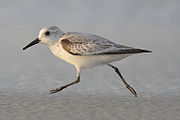
Charadriiformes
Charadriiformes is a diverse order of small to medium-large birds. It includes about 350 species and has members in all parts of the world. Most Charadriiformes live near water and eat invertebrates or other small animals; however, some are pelagic , some occupy deserts and a few are found in thick...
. Family: Scolopacidae
Scolopacidae
The sandpipers are a large family, Scolopacidae, of waders or shorebirds. They include many species called sandpipers, as well as those called by names such as curlew and snipe. The majority of these species eat small invertebrates picked out of the mud or soil...
The Scolopacidae are a large and diverse family of small to medium sized shorebirds which includes the sandpipers, curlews, godwits, shanks, tattlers, woodcocks, snipes, dowitchers and phalaropes. Most eat small invertebrates picked out of the mud or sand. Different lengths of legs and bills enable different species to feed in the same habitat, particularly on the coast, without direct competition for food. There are 86 species worldwide, 65 in North America and 37 in Florida.
- Spotted SandpiperSpotted SandpiperThe Spotted Sandpiper is a small shorebird, 18–20 cm long. Together with its sister species, the Common Sandpiper they make up the genus Actitis...
, Actitis macularius - Solitary SandpiperSolitary SandpiperThe Solitary Sandpiper is a small wader .-Description:This species measures long, with a wingspan up to and a body mass of . It is a dumpy wader with a dark green back, greyish head and breast and otherwise white underparts. It is obvious in flight, with wings dark above and below, and a dark...
, Tringa solitaria - Greater YellowlegsGreater YellowlegsThe Greater Yellowlegs, Tringa melanoleuca, is a large North American shorebird, similar in appearance to the smaller Lesser Yellowlegs. Its closest relative, however, is the Greenshank, which together with the Spotted Redshank form a close-knit group...
, Tringa melanoleuca - Common Greenshank, Tringa nebularia (A)
- WilletWilletThe Willet, Tringa semipalmata , is a large shorebird in the sandpiper family. It is a good-sized and stout scolopacid, the largest of the shanks...
, Tringa semipalmata - Lesser YellowlegsLesser YellowlegsThe Lesser Yellowlegs is a medium-sized shorebird similar in appearance to the larger Greater Yellowlegs. It is not closely related to this bird, however, but instead to the much larger and quite dissimilar Willet; merely the fine, clear and dense pattern of the neck shown in breeding plumage...
, Tringa flavipes - Upland SandpiperUpland SandpiperThe Upland Sandpiper is a large shorebird, closely related to the curlews . Older names are the Upland Plover and Bartram's Sandpiper. It is the only member of the genus Bartramia. The genus name and the old common name Bartram's Sandpiper commemorate the American naturalist William Bartram...
, Bartramia longicauda - WhimbrelWhimbrelThe Whimbrel Numenius phaeopus, is a wader in the large family Scolopacidae. It is one of the mostwidespread of the curlews, breeding across much of subarctic North America, Europe and Asia as far south as Scotland....
, Numenius phaeopus - Long-billed CurlewLong-billed CurlewThe Long-billed Curlew, Numenius americanus, is a large North American shorebird of the family Scolopacidae. This species was also called "sicklebird" and the "candlestick bird". The species is native to central and western North America...
, Numenius americanus - Black-tailed GodwitBlack-tailed GodwitThe Black-tailed Godwit, Limosa limosa, is a large, long-legged, long-billed shorebird first described by Carolus Linnaeus in 1758. It is a member of the Limosa genus, the godwits...
, Limosa limosa (A) - Hudsonian GodwitHudsonian GodwitThe Hudsonian Godwit, Limosa haemastica, is a large shorebird.-Identification:Adults have long dark legs and a long pink bill with a slight upward curve and dark at the tip. The upper parts are mottled brown and the underparts are chestnut. The tail is black and the rump is white...
, Limosa haemastica - Bar-tailed GodwitBar-tailed GodwitThe Bar-tailed Godwit is a large wader in the family Scolopacidae, which breeds on Arctic coasts and tundra mainly in the Old World, and winters on coasts in temperate and tropical regions of the Old World...
, Limosa lapponica (A) - Marbled GodwitMarbled GodwitThe Marbled Godwit, Limosa fedoa, is a large shorebird. On average, it is the largest of the 4 species of godwit. The total length is , including a large bill of , and wingspan is . Body mass can vary from ....
, Limosa fedoa - Ruddy TurnstoneRuddy TurnstoneThe Ruddy Turnstone is a small wading bird, one of two species of turnstone in the genus Arenaria. It is now classified in the sandpiper family Scolopacidae but was formerly sometimes placed in the plover family Charadriidae...
, Arenaria interpres - SurfbirdSurfbirdThe Surfbird is a small stocky wader in the family Scolopacidae. It is usually classified in a genus of its own, as Aphriza virgata, and was once considered to be allied to the turnstones, but more recent data suggests it is very close genetically to the Red and Great Knots and should be included...
, Aphriza virgata (A) - Red KnotRed KnotThe Red Knot, Calidris canutus , is a medium sized shorebird which breeds in tundra and the Arctic Cordillera in the far north of Canada, Europe, and Russia. It is a large member of the Calidris sandpipers, second only to the Great Knot...
, Calidris canutus - SanderlingSanderlingThe Sanderling is a small wader. It is a circumpolar Arctic breeder, and is a long-distance migrant, wintering south to South America, South Europe, Africa, and Australia...
, Calidris alba - Semipalmated SandpiperSemipalmated SandpiperThe Semipalmated Sandpiper, Calidris pusilla, is a very small shorebird. It is sometimes separated with other "stints" in Erolia but although these apparently form a monophyletic group, the present species' old genus Ereunetes had been proposed before Erolia.Adults have black legs and a short stout...
, Calidris pusilla - Western SandpiperWestern SandpiperThe Western Sandpiper, Calidris or Erolia mauri, is a small shorebird.Adults have dark legs and a short thin dark bill, thinner at the tip. The body is brown on top and white underneath. They are reddish-brown on the crown. This bird can be difficult to distinguish from other similar tiny...
, Calidris mauri - Least SandpiperLeast SandpiperThe Least Sandpiper is the smallest shorebird.This species has greenish legs and a short thin dark bill. Breeding adults are brown with dark brown streaks on top and white underneath. They have a light line above the eye and a dark crown. In winter, Least Sandpipers are grey above...
, Calidris minutilla - White-rumped SandpiperWhite-rumped SandpiperThe White-rumped Sandpiper is a small shorebird.Adults have black legs and a small thin dark bill. The body is dark brown on top and mainly white underneath, with brown streaks on the breast and a white rump. They have a white stripe over their eyes. This bird shows long wings in flight. In winter...
, Calidris fuscicollis - Baird's SandpiperBaird's SandpiperThe Baird's Sandpiper is a small shorebird. It is among those calidrids sometimes separated in Erolia.Adults have black legs and a short thin dark bill. They are dark brown on top and mainly white underneath with a black patch on the rump. The head and breast are light brown with dark streaks. In...
, Calidris bairdii - Pectoral SandpiperPectoral SandpiperThe Pectoral Sandpiper, Calidris melanotos, is a small wader. It is sometimes separated with the "stint" sandpipers in Erolia. This may or may not represent a good monophyletic group, depending on the placement of the phylogenetically enigmatic Curlew Sandpiper , the type species of Erolia...
, Calidris melanotos - Sharp-tailed SandpiperSharp-tailed SandpiperThe Sharp-tailed Sandpiper, Calidris acuminata is a small wader.- Taxonomy :More recently, a review of new data has indicated that this bird should perhaps better be placed into the genus Philomachus- as P...
, Calidris acuminata (A) - Purple SandpiperPurple SandpiperThe Purple Sandpiper, Calidris, Arquatella or Erolia maritima is a small shorebird.Adults have short yellow legs and a medium thin dark bill with a yellow base. The body is dark on top with a slight purplish gloss and mainly white underneath. The breast is smeared with grey and the rump is black...
, Calidris maritima - DunlinDunlinThe Dunlin, Calidris alpina, is a small wader, sometimes separated with the other "stints" in Erolia. It is a circumpolar breeder in Arctic or subarctic regions. Birds that breed in northern Europe and Asia are long-distance migrants, wintering south to Africa, southeast Asia and the Middle East...
, Calidris alpina - Curlew SandpiperCurlew SandpiperThe Curlew Sandpiper is a small wader that breeds on the tundra of Arctic Siberia. It is strongly migratory, wintering mainly in Africa, but also in south and southeast Asia and in Australasia...
, Calidris ferruginea - Stilt SandpiperStilt SandpiperThe Stilt Sandpiper, Calidris himantopus or Micropalama himantopus, is a small shorebird; it bears some resemblance to the smaller calidrid sandpipers or "stints". DNA sequence information is incapable of determining whether it should be placed in Calidris or in the monotypic genus Micropalama...
, Calidris himantopus - Buff-breasted SandpiperBuff-breasted SandpiperThe Buff-breasted Sandpiper, Tryngites subruficollis, is a small shorebird. It is a calidrid sandpipers and currently considered to be the only member of the genus Tryngites. Indeed, it probably belongs in the genus Calidris itself, or more precisely with the small species thereof which should be...
, Tryngites subruficollis - Ruff, Philomachus pugnax
- Short-billed DowitcherShort-billed DowitcherThe Short-billed Dowitcher like its congener the Long-billed Dowitcher, is a medium-sized, stocky, long-billed shorebird in the family Scolopacidae. It is an inhabitant of North America, Middle America, and northern South America. It is strongly migratory; it completely vacates in breeding areas...
, Limnodromus griseus - Long-billed DowitcherLong-billed DowitcherThe Long-billed Dowitcher, Limnodromus scolopaceus, is a medium-sized shorebird.Adults have yellowish legs and a long straight dark bill. The body is dark brown on top and reddish underneath with spotted throat and breast, bars on flanks. The tail has a black and white barred pattern...
, Limnodromus scolopaceus - Wilson's SnipeWilson's SnipeWilson's Snipe is a small, stocky shorebird. This species was formerly considered to be a subspecies of the Common Snipe, G. gallinago. Wilson's Snipe differs from the latter species in having a narrower white edge to the wings, and eight pairs of tail feathers instead of seven.Adults are...
, Gallinago delicata - American WoodcockAmerican WoodcockThe American Woodcock , sometimes colloquially referred to as the Timberdoodle, is a small chunky shorebird species found primarily in the eastern half of North America...
, Scolopax minor - Wilson's PhalaropeWilson's PhalaropeThe Wilson's Phalarope, Phalaropus tricolor, is a small wader. This bird, the largest of the phalaropes, breeds in the prairies of North America in western Canada and the western United States. It is migratory, wintering around the central Andes in South America. They are passage migrants through...
, Phalaropus tricolor - Red-necked PhalaropeRed-necked PhalaropeThe Red-necked Phalarope, Phalaropus lobatus, is a small wader. This phalarope breeds in the Arctic regions of North America and Eurasia. It is migratory, and, unusually for a wader, winters at sea on tropical oceans....
, Phalaropus lobatus - Red PhalaropeRed PhalaropeThe Red Phalarope , Phalaropus fulicarius, is a small wader. This phalarope breeds in the Arctic regions of North America and Eurasia...
, Phalaropus fulicarius
Gulls, terns, and skimmers

Charadriiformes
Charadriiformes is a diverse order of small to medium-large birds. It includes about 350 species and has members in all parts of the world. Most Charadriiformes live near water and eat invertebrates or other small animals; however, some are pelagic , some occupy deserts and a few are found in thick...
. Family: Laridae
The Laridae are a family of medium to large seabirds and containing the gulls, terns, kittiwakes and skimmers. They are typically grey or white, often with black markings on the head or wings. They have stout, longish bills and webbed feet. There are 103 species worldwide, 58 in North America and 35 in Florida.
- Black-legged KittiwakeBlack-legged KittiwakeThe Black-legged Kittiwake is a seabird species in the gull family Laridae.This species was first described by Linnaeus in his Systema naturae in 1758 as Larus tridactylus....
, Rissa tridactyla - Sabine's GullSabine's GullThe Sabine's Gull is a small gull. Its generic placement is disputed; some authors treat it as the sole species in the genus Xema as Xema sabini, while others retain it in the genus Larus as Larus sabini. It breeds in the arctic and has a circumpolar distribution through northernmost North America...
, Xema sabini - Bonaparte's GullBonaparte's GullThe Bonaparte's Gull is a small gull.The Bonaparte's Gull is a small species, larger only than the Little Gull and the Saunders's Gull among all gull species. Adults are long with a wingspan and a body mass of . They have a black hood and a short thin dark bill. The body is mainly white with...
, Chroicocephalus philadelphia - Gray-hooded Gull, Chroicocephalus cirrocephhalus (A)
- Black-headed GullBlack-headed GullThe Black-headed Gull is a small gull which breeds in much of Europe and Asia, and also in coastal eastern Canada. Most of the population is migratory, wintering further south, but some birds in the milder westernmost areas of Europe are resident...
, Chroicocephalus ridibundus (A) - Little GullLittle GullThe Little Gull, Hydrocoloeus minutus or Larus minutus, is a small gull which breeds in northern Europe and Asia. It also has small colonies in parts of southern Canada. It is migratory, wintering on coasts in western Europe, the Mediterranean and the northeast USA. As is the case with many gulls,...
, Hydrocoleus minutus (A) - Laughing GullLaughing GullThe Laughing Gull, Leucophaeus atricilla, is a medium-sized gull of North and South America. It breeds on the Atlantic coast of North America, the Caribbean, and northern South America. Northernmost populations migrate further south in winter, and this species occurs as a rare vagrant to western...
, Leucophaeus atricilla - Franklin's GullFranklin's GullThe Franklin's Gull is a small gull.-Description:It breeds in central provinces of Canada and adjacent states of the northern United States...
, Leucophaeus pipixcan - Belcher's GullBelcher's GullThe Belcher's Gull , also known as the or Band-tailed Gull, is a gull found along the Pacific coast of South America. It formerly included the very similar Olrog's Gull as a subspecies. It is a medium-sized gull with a blackish mantle, white head and underparts, a black band in the otherwise white...
, Larus belcheri (A) - Heermann's GullHeermann's GullThe Heermann's Gull is a gull resident in the United States, Mexico and extreme southwestern British Columbia. Of the current population of about 150,000 pairs, 90% nest on the island of Isla Rasa off Baja California in the Gulf of California, with smaller colonies as far north as California and...
, Larus heermanni (A) - Ring-billed GullRing-billed GullThe Ring-billed Gull is a medium-sized gull.Adults are length and with a wingspan. The head, neck and underparts are white; the relatively short bill is yellow with a dark ring; the back and wings are silver gray; and the legs are yellow. The eyes are yellow with red rims...
, Larus delawarensis - California GullCalifornia GullThe California Gull Larus californicus is a medium-sized gull, smaller on average than the Herring Gull but larger on average than the Ring-billed Gull, though may overlap in size greatly with both....
, Larus californicus (A) - Herring GullAmerican Herring GullThe American Herring Gull or Smithsonian Gull is a large gull which breeds in North America. It is often treated as a subspecies of the European Herring Gull but is now regarded as a separate species by some authorities.Adults are white with gray back and wings, black wingtips with white spots,...
, Larus argentatus - "Vega Gull", Larus argentatus vega (A)
- Thayer's GullThayer's GullThe Thayer's Gull is a large gull native to North America that breeds in the Arctic islands of Canada and primarily winters on the Pacific coast, from southern Alaska to the Gulf of California, though there are also wintering populations on the Great Lakes and the upper Mississippi River...
, Larus thayeri (A) - Iceland GullIceland GullThe Iceland Gull, Larus glaucoides, is a large gull which breeds in the Arctic regions of Canada and Greenland, but not Iceland, where it is only seen in the winter. It is migratory, wintering from in the North Atlantic as far south as the British Isles and northernmost states of the eastern USA,...
, Larus glaucoides - Lesser Black-backed GullLesser Black-backed GullThe Lesser Black-backed Gull is a large gull that breeds on the Atlantic coasts of Europe. It is migratory, wintering from the British Isles south to West Africa...
, Larus fuscus - Slaty-backed GullSlaty-backed GullThe Slaty-backed Gull , is a large white-headed gull that breeds on the western coast of Alaska but travels widely during nonbreeding seasons. Claims have been made as to its presence throughout North America as well as the eastern coast of Asia. It is similar in appearance to the Western Gull...
, Larus schistisagus (A) - Glaucous GullGlaucous GullThe Glaucous Gull is a large gull which breeds in the Arctic regions of the northern hemisphere and the Atlantic coasts of Europe. It is migratory, wintering from in the North Atlantic and North Pacific oceans as far south as the British Isles and northernmost states of the USA, also on the Great...
, Larus hyperboreus - Great Black-backed GullGreat Black-backed GullThe Great Black-backed Gull is the largest gull in the world, which breeds on the European and North American coasts and islands of the North Atlantic...
, Larus marinus - Brown NoddyBrown NoddyThe Brown Noddy or Common Noddy is a seabird from the tern family. The largest of the noddies, it can be told from the closely related Black Noddy by its larger size and plumage, which is dark brown rather than black...
, Anous stolidus
- Black NoddyBlack NoddyThe Black Noddy or White-capped Noddy is a seabird from the tern family. It resembles the closely related Brown or Common Noddy , but is smaller with darker plumage, a whiter cap, a longer, straighter beak and shorter tail...
, Anous minutus - Sooty TernSooty TernThe Sooty Tern, Onychoprion fuscatus , is a seabird of the tern family . It is a bird of the tropical oceans, breeding on islands throughout the equatorial zone. Colloquially, it is known as the Wideawake Tern or just wideawake...
, Onychoprion fuscata - Bridled TernBridled TernThe Bridled Tern is a seabird of the tern family Sternidae. It is a bird of the tropical oceans.-Description:...
, Onychoprion anaethetus - Least Tern, Sternula antillarum
- Gull-billed TernGull-billed TernThe Gull-billed Tern formerly Sterna nilotica , is a seabird of the tern family Sternidae...
, Gelochelidon nilotica - Caspian TernCaspian TernThe Caspian Tern is a species of tern, with a subcosmopolitan but scattered distribution. Despite its extensive range, it is monotypic of its genus, and has no subspecies accepted either...
, Hydroprogne caspia - Black TernBlack TernThe Black Tern, Chlidonias niger, is a small tern generally found in or near inland water in Europe and North America. As its name suggests, it has predominantly dark plumage.- Description :...
, Chlidonias niger - Roseate TernRoseate TernThe Roseate Tern is a seabird of the tern family Sternidae. This bird has a number of geographical races, differing mainly in bill colour and minor plumage details....
, Sterna dougallii - Common TernCommon TernThe Common Tern is a seabird of the tern family Sternidae. This bird has a circumpolar distribution, breeding in temperate and sub-Arctic regions of Europe, Asia and east and central North America. It is strongly migratory, wintering in coastal tropical and subtropical regions. It is sometimes...
, Sterna hirundo - Arctic TernArctic TernThe Arctic Tern is a seabird of the tern family Sternidae. This bird has a circumpolar breeding distribution covering the Arctic and sub-Arctic regions of Europe, Asia, and North America...
, Sterna paradisaea - Forster's TernForster's TernThe Forster's Tern, Sterna forsteri, is a member of the tern family Sternidae. It breeds inland in North America and winters south to the Caribbean and northern South America....
, Sterna forsteri - Royal TernRoyal TernThe Royal Tern is a seabird in the tern family Sternidae. This bird has two distinctive subspecies. T. m. maximus breeds on the Atlantic and Pacific coasts of the southern USA and Mexico into the Caribbean. The slightly smaller T. m. albididorsalis breeds in coastal west Africa...
, Thalasseus maxima - Sandwich Tern, Thalasseus sandvicensis
- Elegant TernElegant TernThe Elegant Tern is a seabird of the tern family Sternidae. It breeds on the Pacific coasts of the southern USA and Mexico and winters south to Peru, Ecuador and Chile....
, Thalasseus elegans (A) - Black SkimmerBlack SkimmerThe Black Skimmer, Rynchops niger, is a tern-like seabird, one of three very similar birds species in the skimmer family. It breeds in North and South America...
, Rynchops niger
Skuas

Charadriiformes
Charadriiformes is a diverse order of small to medium-large birds. It includes about 350 species and has members in all parts of the world. Most Charadriiformes live near water and eat invertebrates or other small animals; however, some are pelagic , some occupy deserts and a few are found in thick...
Family: Stercorariidae
Skuas are medium to large seabird
Seabird
Seabirds are birds that have adapted to life within the marine environment. While seabirds vary greatly in lifestyle, behaviour and physiology, they often exhibit striking convergent evolution, as the same environmental problems and feeding niches have resulted in similar adaptations...
s, typically with grey or brown plumage, often with white markings on the wings. They have longish bills with a hooked tip, and webbed feet with sharp claws. They look like large dark gulls, but have a fleshy cere above the upper mandible. They are strong, acrobatic fliers. There are seven species worldwide, five in North America and four in Florida.
- South Polar SkuaSouth Polar SkuaThe South Polar Skua, Stercorarius maccormicki, is a large seabird in the skua family Stercorariidae. An older name for the bird is MacCormick’s Skua, after explorer and naval surgeon Robert McCormick, who first collected the type specimen...
, Stercorarius maccormicki (A) - Pomarine Jaeger, Stercorarius pomarinus
- Parasitic Jaeger, Stercorarius parasiticus
- Long-tailed Jaeger, Stercorarius longicaudus
Alcids
Order: CharadriiformesCharadriiformes
Charadriiformes is a diverse order of small to medium-large birds. It includes about 350 species and has members in all parts of the world. Most Charadriiformes live near water and eat invertebrates or other small animals; however, some are pelagic , some occupy deserts and a few are found in thick...
Family: Alcidae
Alcids are superficially similar to penguin
Penguin
Penguins are a group of aquatic, flightless birds living almost exclusively in the southern hemisphere, especially in Antarctica. Highly adapted for life in the water, penguins have countershaded dark and white plumage, and their wings have become flippers...
s due to their black-and-white colours, their upright posture and some of their habits; however they are not closely related to penguins, and are (with one extinct exception) able to fly. Auks live on the open sea, only deliberately coming ashore to breed. There are 24 species worldwide, 22 in North America and six in Florida.
- Dovekie, Alle alle
- Thick-billed Murre, Uria lomvia (A)
- RazorbillRazorbillThe Razorbill is colonial seabird that will only come to land in order to breed. It is the largest living member of the Auk family. This agile bird will choose only one partner for life and females will lay one egg per year. Razorbills will nest along coastal cliffs in enclosed or slightly exposed...
, Alca forda (A) - Long-billed MurreletLong-billed MurreletThe Long-billed Murrelet is a small seabird from the North Pacific. It is an unusual member of the auk family, often nesting far inland in old growth forests...
, Brachyrampus perdix (A) - Ancient MurreletAncient MurreletThe Ancient Murrelet, Synthliboramphus antiquus, is a bird in the auk family. It breeds from the Yellow Sea , through the Russian Pacific coast and the Aleutian Islands to the Haida Gwaii archipelago of British Columbia, where about half of the world population breeds.These birds breed in colonies,...
, Synthliboramphus antiquus (A) - Atlantic PuffinAtlantic PuffinThe Atlantic Puffin is a seabird species in the auk family. It is a pelagic bird that feeds primarily by diving for fish, but also eats other sea creatures, such as squid and crustaceans. Its most obvious characteristic during the breeding season is its brightly coloured bill...
, Fratercula arctica (A)
Pigeons and doves
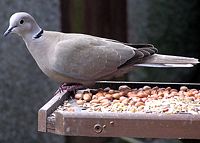
Columbiformes
Columbiformes are an avian order that includes the very widespread and successful doves and pigeons, classified in the family Columbidae, and the extinct Dodo and the Rodrigues Solitaire, long classified as a second family Raphidae. 313 species, found worldwide, comprise the Columbiformes order....
Family: Columbidae
Pigeons and doves are stout-bodied birds with short necks, and short slender bills with a fleshy cere. There are 308 species worldwide, 50 in North America and 14 in Florida.
- Rock Pigeon, Columba livia (I)
- Scaly-naped PigeonScaly-naped PigeonThe Scaly-naped Pigeon , also known as the Red-necked Pigeon, is a bird belonging to the family Columbidae. The species occurs throughout the Caribbean.- Description :...
, Patagioenas squamosa (A) - White-crowned PigeonWhite-crowned PigeonThe White-crowned Pigeon is a species of bird in the family Columbidae . It inhabits the northern and central Caribbean islands and some places on the North and Central American mainland...
, Patagioenas leucocephala - Band-tailed PigeonBand-tailed PigeonThe Band-tailed Pigeon, Patagioenas fasciata, is a medium-sized bird of the Americas. Its closest relatives are the Chilean Pigeon and the Ring-tailed Pigeon, which form a clade of Patagioenas with a terminal tail band and iridescent plumage on their necks.It ranges from British Columbia, Utah, and...
, Patagioenas fasciata (A) - European Turtle-Dove, Streptopelia turtur (A)
- Eurasian Collared-DoveEurasian Collared DoveThe Eurasian Collared Dove most often simply called the Collared Dove, also sometimes hyphenated as Eurasian Collared-dove is a species of dove native to Asia and Europe, and also recently introduced in North America....
, Streptopelia decaocto (I) - White-winged DoveWhite-winged DoveThe White-winged Dove is a dove whose native range extends from the south-western USA through Mexico, Central America, and the Caribbean. In recent years with increasing urbanization and backyard feeding, it has expanded throughout Texas and into Louisiana...
, Zenaida asiatica (i) - Zenaida DoveZenaida DoveThe Zenaida Dove is a member of the bird family Columbidae, which includes doves and pigeons. It is the national bird of Anguilla, where it is commonly referred to as a Turtle Dove. It lays two white eggs on a flimsy platform built on a tree or shrub. It also nests in rock crevices and on grassy...
, Zenaida aurita (A) - Mourning DoveMourning DoveThe Mourning Dove is a member of the dove family . The bird is also called the Turtle Dove or the American Mourning Dove or Rain Dove, and formerly was known as the Carolina Pigeon or Carolina Turtledove. It is one of the most abundant and widespread of all North American birds...
, Zenaida macroura - Passenger PigeonPassenger PigeonThe Passenger Pigeon or Wild Pigeon was a bird, now extinct, that existed in North America and lived in enormous migratory flocks until the early 20th century...
, Ectopistes migratorius (E) - Common Ground-DoveCommon Ground DoveThe Common Ground Dove is a small bird that inhabits the southern United States, parts of Central America, the Caribbean and northern South America. The Common Ground Dove is considered to be the smallest dove that inhabits the United States...
, Columbina passerina - White-tipped DoveWhite-tipped DoveThe White-tipped Dove is a large New World tropical dove. It is a resident breeder from the southernmost Texas in the USA through Mexico and Central America south to western Peru and central Argentina. It also breeds on the offshore islands of northern South America, including Trinidad and Tobago...
, Leptotila verreauxi (A) - Key West Quail-DoveKey West Quail-DoveThe Key West Quail-Dove is a member of the bird family Columbidae, which includes doves and pigeons.The Key West Quail-Dove breeds in the Bahamas and, except for Jamaica, throughout the Greater Antilles. It formerly bred in the Florida Keys and southernmost mainland Florida. It was discovered on...
, Geotrygon chrysia - Ruddy Quail-DoveRuddy Quail-DoveThe Ruddy Quail-Dove is a member of the bird family Columbidae, which includes doves and pigeons.It breeds throughout the West Indies, Central America, and tropical South America. It has appeared as a vagrant in Florida and southern Texas. It lays two buff colored eggs on a flimsy platform...
, Geotrygon montana (A)
Parrots
Order: PsittaciformesParrot
Parrots, also known as psittacines , are birds of the roughly 372 species in 86 genera that make up the order Psittaciformes, found in most tropical and subtropical regions. The order is subdivided into three families: the Psittacidae , the Cacatuidae and the Strigopidae...
Family: Psittacidae
True parrots
The true parrots are about 330 species of bird belonging to the Psittacidae family, one of the two "traditional" families in the biological order Psittaciformes . The other family is the Cacatuidae which are also parrots, but not classified as true parrots...
Parrots are small to large birds with characteristic curved beaks. Their upper mandibles have slight mobility in the joint with the skull and they have a generally erect stance. All parrots are zygodactyl, having the four toes on each foot placed two at the front and two behind. There are 335 species worldwide, 54 in North America and five in Florida.
- BudgerigarBudgerigarThe Budgerigar , also known as Common Pet Parakeet or Shell Parakeet informally nicknamed the budgie, is a small, long-tailed, seed-eating parrot, and the only species in the Australian genus Melopsittacus...
, Melopsittacus undulatus (I) - Monk ParakeetMonk ParakeetThe Monk Parakeet, also known as the Quaker Parrot, is a species of parrot, in most treatments the only member of the genus Myiopsitta. It originates from the temperate to subtropical areas of Argentina and the surrounding countries in South America...
, Myiopsitta monachus (I) - Carolina ParakeetCarolina ParakeetThe Carolina Parakeet was the only parrot species native to the eastern United States. It was found from the Ohio Valley to the Gulf of Mexico, and lived in old forests along rivers. It was the only species at the time classified in the genus Conuropsis...
, Conuropsis carolinensis (E) - Black-hooded Parakeet, Nandayus nenday (I)
- White-winged ParakeetCanary-winged ParakeetThe White-winged Parakeet , also known as the Canary-winged Parakeet, is a small parrot native to the Amazon River basin from southeast Colombia to the River’s mouth in Brazil...
, Brotogeris versicolurus (I)
Cuckoos, roadrunners, and anis
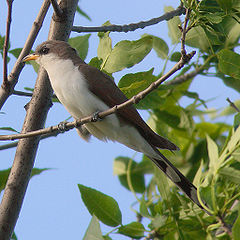
Cuculiformes
The near passerine bird order Cuculiformes traditionally included three families as below:* Musophagidae - turacos and allies* Cuculidae - cuckoos, coucals, roadrunners and anis* Opisthocomidae - Hoatzin...
Family: Cuculidae
The family Cuculidae includes cuckoos, roadrunners and anis. These birds are of variable size with slender bodies, long tails and strong legs. Unlike the cuckoo species of the Old World, North American cuckoos are not brood parasites. There are 138 species worldwide, 25 in North America and five in Florida.
- Yellow-billed CuckooYellow-billed CuckooThe Yellow-billed Cuckoo, Coccyzus americanus, is a cuckoo. Common folk-names for this bird in the southern United States are Rain Crow and Storm Crow...
, Coccyzus americanus - Mangrove CuckooMangrove CuckooThe Mangrove Cuckoo, Coccyzus minor, is a species of cuckoo that is native to the Neotropics.Adults have a long tail, brown above and black-and-white below, and a black curved bill with yellow on the lower mandible. The head and upper parts are brown. There is a yellow ring around the eye...
, Coccyzus minor - Black-billed CuckooBlack-billed CuckooThe Black-billed Cuckoo, Coccyzus erythropthalmus, is a cuckoo.Adults have a long brown tail and a black bill. The head and upper parts are brown and the underparts are white. There is a red ring around the eye. Juveniles are drabber, and the eye ring is greenish.Their breeding habitat is edges of...
, Coccyzus erythropthalmus - Smooth-billed AniSmooth-billed AniThe Smooth-billed Ani is a large near passerine bird in the cuckoo family. It is a resident breeding species from southern Florida, the Bahamas, the Caribbean, parts of Central America, south to western Ecuador, Brazil, and northern Argentina.This ani is found in open and semi-open country and...
, Crotophaga ani - Groove-billed AniGroove-billed AniThe Groove-billed Ani, Crotophaga sulcirostris, is an odd-looking tropical bird in the cuckoo family with a long tail and a large, curved beak. It is a resident species throughout most of its range, from southern Texas and central Mexico through Central America, to northern Colombia and Venezuela,...
, Crotophaga sulcirostris
Barn owls
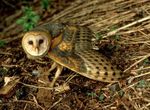
Family: Tytonidae
Tytonidae
Barn-owls are one of the two families of owls, the other being the true owls, Strigidae. They are medium to large sized owls with large heads and characteristic heart-shaped faces. They have long, strong legs with powerful talons...
Barn owls are medium to large sized owls with large heads and characteristic heart-shaped faces. They have long strong legs with powerful talons. There are 16 species worldwide, two in North America and one in Florida.
- Barn OwlBarn OwlThe Barn Owl is the most widely distributed species of owl, and one of the most widespread of all birds. It is also referred to as Common Barn Owl, to distinguish it from other species in the barn-owl family Tytonidae. These form one of two main lineages of living owls, the other being the typical...
, Tyto alba
Typical owls
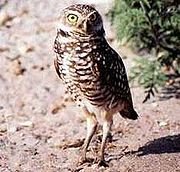
Family: Strigidae
Typical owls are small to large solitary nocturnal birds of prey. They have large forward-facing eyes and ears, a hawk-like beak, and a conspicuous circle of feathers around each eye called a facial disk. There are 195 species worldwide, 42 in North America and nine in Florida.
- Flammulated OwlFlammulated OwlThe Flammulated Owl is a small, nocturnal owl approximately 15 cm long with a 36 cm wingspan. Males and females can be distinguished by their weight. Females are larger, ranging from 62-65 grams and males are smaller ranging from 50-52 grams. The owl gets the name flammulated from the flame...
, Otus flammeolus (A) - Eastern Screech-OwlEastern Screech OwlThe Eastern Screech Owl or Eastern Screech-Owl is a small owl that is relatively common in Eastern North America, from Mexico to Canada.-Description:...
, Megascops asio - Great Horned OwlGreat Horned OwlThe Great Horned Owl, , also known as the Tiger Owl, is a large owl native to the Americas. It is an adaptable bird with a vast range and is the most widely distributed true owl in the Americas.-Description:...
, Bubo virginianus - Snowy OwlSnowy OwlThe Snowy Owl is a large owl of the typical owl family Strigidae. The Snowy Owl was first classified in 1758 by Carolus Linnaeus, the Swedish naturalist who developed binomial nomenclature to classify and organize plants and animals. The bird is also known in North America as the Arctic Owl, Great...
, Bubo scandiacus (A) - Burrowing OwlBurrowing OwlThe Burrowing Owl is a tiny but long-legged owl found throughout open landscapes of North and South America. Burrowing Owls can be found in grasslands, rangelands, agricultural areas, deserts, or any other open dry area with low vegetation. They nest and roost in burrows, such as those excavated...
, Athene cunicularia - Barred OwlBarred OwlThe Barred Owl is a large typical owl. It goes by many other names, including eight hooter, rain owl, wood owl, and striped owl, but is probably best known as the hoot owl.-Description:...
, Strix varia - Long-eared OwlLong-eared OwlThe Long-eared Owl - Asio otus is a species of owl which breeds in Europe, Asia, and North America. This species is a part of the larger grouping of owls known as typical owls, family Strigidae, which contains most species of owl...
, Asio otus (A) - Short-eared OwlShort-eared OwlThe Short-eared Owl is a species of typical owl . In Scotland this species of owl is often referred to as a cataface, grass owl or short-horned hootlet. Owls belonging to genus Asio are known as the eared owls, as they have tufts of feathers resembling mammalian ears. These "ear" tufts may or may...
, Asio flammeus - Northern Saw-whet OwlNorthern Saw-whet OwlThe Northern Saw-whet Owl is a small owl native to North America.-Description:The scientific description of one of the sub-species of this owl is attributed to the Rev. John Henry Keen who was a missionary in Canada in 1896. Adults are long with a wingspan. They can weigh from with an average...
, Aegolius acadicus (A)
Nightjars
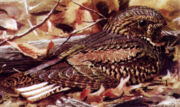
Caprimulgiformes
The Caprimulgiformes is an order of birds that includes a number of birds with global distribution . They are generally insectivorous and nocturnal...
Family: Caprimulgidae
Nightjars are medium-sized nocturnal birds with long wings, short legs and very short bills that usually nest on the ground. Most have small feet, of little use for walking, and long pointed wings. Their soft plumage is crypically coloured to resemble bark or leaves. There are 86 species worldwide, 23 in North America and five in Florida.
- Lesser NighthawkLesser NighthawkThe Lesser Nighthawk, Chordeiles acutipennis, is a nightjar found throughout a large part of the Americas.The adults are dark with brown, grey and white patterning on the upperparts and breast; the long upperwings are black and show a white bar in flight. The tail is dark with white barring; the...
, Chordeiles acutipennis - Common NighthawkCommon NighthawkThe Common Nighthawk is a medium-sized crepuscular or nocturnal bird, whose presence and identity are best revealed by its vocalization. Typically dark , displaying cryptic colouration and intricate patterns, this bird becomes invisible by day. Once aerial, with its buoyant but erratic flight,...
, Chordeiles minor - Antillean NighthawkAntillean NighthawkThe Antillean Nighthawk, Chordeiles gundlachii, is a nightjar.The adults are dark with brown, grey and white patterning on the upperparts and breast; the long wings are black and show a white bar in flight. The tail is dark with white barring; the underparts are white with black bars. The adult...
, Chordeiles gundlachii - Chuck-will's-widowChuck-will's-widowThe Chuck-will's-widow, Caprimulgus carolinensis is a nocturnal bird of the nightjar family Caprimulgidae. It is found in the southeastern United States near swamps, rocky uplands, and pine woods...
, Caprimulgus carolinensis - Eastern Whip-poor-will, Caprimulgus vociferus
Swifts
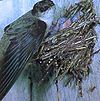
Apodiformes
Traditionally, the bird order Apodiformes contained three living families: the swifts , the tree swifts , and the hummingbirds . In the Sibley-Ahlquist taxonomy, this order is raised to a superorder Apodimorphae in which hummingbirds are separated as a new order, Trochiliformes...
Family: Apodidae
The swifts are small aerial birds, spending most of their lives flying. They have very short legs and never settle voluntarily on the ground, perching instead only on vertical surfaces. Many swifts have very long swept-back wings that resemble a crescent or a boomerang. There are 98 species worldwide, 25 in North America, and five in Florida.
- White-collared SwiftWhite-collared SwiftThe White-collared Swift, Streptoprocne zonaris, is a resident breeding bird from central Mexico, the Greater Antilles and Trinidad south to Peru, northern Argentina and southeastern Brazil....
, Streptoprocne zonaris (A) - Chimney SwiftChimney SwiftThe Chimney Swift is a small bird .-Physical description:In flight, this bird looks like a flying cigar with long slender curved wings. The plumage is a sooty grey-brown; the throat, breast, underwings and rump are paler. They have short tails.-Reproduction:The breeding season of Chimney Swifts is...
, Chaetura pelagica - Vaux's SwiftVaux's SwiftVaux's Swift is a small swift native to North America and northern South America. It was named for the American scientist William Sansom Vaux.-Description:...
, Chaetura vauxi (A) - White-throated SwiftWhite-throated SwiftThe White-throated Swift is a swift of the family Apodidae native to western North America, south to cordilleran western Honduras...
, Aeronautes saxatalis (A) - Antillean Palm-Swift, Tachornis phoenicobia (A)
Hummingbirds
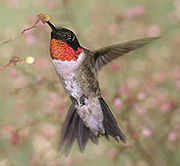
Apodiformes
Traditionally, the bird order Apodiformes contained three living families: the swifts , the tree swifts , and the hummingbirds . In the Sibley-Ahlquist taxonomy, this order is raised to a superorder Apodimorphae in which hummingbirds are separated as a new order, Trochiliformes...
Family: Trochilidae
Hummingbirds are small birds capable of hovering in mid-air due to the rapid flapping of their wings. They are the only birds that can fly backwards. There are 337 species worldwide, all found only in the Americas, 120 in North America and eleven in Florida.
- Broad-billed HummingbirdBroad-billed HummingbirdThe Broad-billed Hummingbird, Cynanthus latirostris, is a medium-sized hummingbird. It is 9–10 cm long, and weighs approximately three to four grams....
, Cynanthus latirostris (A) - White-eared HummingbirdWhite-eared HummingbirdThe White-eared Hummingbird, Basilinna leucotis , is a medium-sized hummingbird. It is 9-10 cm long, and weighs approximately 3-4 g.- Overview :...
, Hylocharis leucotis (A) - Buff-bellied HummingbirdBuff-bellied HummingbirdThe Buff-bellied Hummingbird, Amazilia yucatanensis, is a medium-sized hummingbird. It is long and has a mass of .Adults are a metallic olive green above and buffy in the lower breast. The tail and primary wings are rufous in color and slightly forked. The underwing is white. The bill of the male...
, Amazila yucatanensis - Bahama WoodstarBahama WoodstarThe Bahama Woodstar is a species of hummingbird.The Bahama Woodstar is a medium-sized hummingbird, growing to be about 3 to 5 inches in length. They are green above with mixed olive-buff underparts. Bills on both the male and female are slightly decurved. Males show a reddish-pink throat is lined...
, Calliphlox evelynae (A) - Ruby-throated HummingbirdRuby-throated HummingbirdThe Ruby-throated Hummingbird , is a small hummingbird. It is the only species of hummingbird that regularly nests east of the Mississippi River in North America.- Description :...
, Archilochus colubris - Black-chinned HummingbirdBlack-chinned HummingbirdThe Black-chinned Hummingbird is a small hummingbird.Adults are metallic green above and white below with green flanks. Their bill is long, straight and very slender. The adult male has a black face and chin, a glossy purple throat band and a dark forked tail...
, Archilochus alexandri - Anna's HummingbirdAnna's HummingbirdAnna's Hummingbird is a medium-sized hummingbird native to the west coast of North America. This bird was named after Anna Masséna, Duchess of Rivoli.-Description:...
, Calypte anna (A) - Calliope HummingbirdCalliope HummingbirdThe Calliope Hummingbird is a very small hummingbird and the smallest bird found in Canada and the United States. It is the only member of the Stellula genus....
, Stellula calliope - Broad-tailed HummingbirdBroad-tailed HummingbirdThe Broad-tailed hummingbird, Selasphorus platycercus, is a medium-sized hummingbird, nearly in length.Male and female both have iridescent green backs and crowns and a white breast. The male has a gorget that shines with a brilliant red iridescence...
, Selasphorus platycercus (A) - Rufous HummingbirdRufous HummingbirdThe Rufous Hummingbird is a small hummingbird, about 8 cm long with a long, straight and very slender bill. The female is slightly larger than the male.-Description:...
, Selasphorus rufus - Allen's HummingbirdAllen's HummingbirdThe Allen's Hummingbird, Selasphorus sasin, is a species of hummingbird.The Allen's Hummingbird is a small bird, with mature adults reaching only 3 to 3½ inches in length. The male Allen's has a green back and forehead, with rust-colored rufous flanks, rump, and tail. The male's throat is also an...
, Selasphorus sasin (A)
Kingfishers

Coraciiformes
The Coraciiformes are a group of usually colorful near passerine birds including the kingfishers, the Hoopoe, the bee-eaters, the rollers, and the hornbills...
Family: Alcedinidae
Kingfishers are medium-sized birds with large heads, long pointed bills, short legs, and stubby tails. There are 94 species worldwide, six in North America and one in Florida.
- Belted KingfisherBelted KingfisherThe Belted Kingfisher is a large, conspicuous water kingfisher, the only member of that group commonly found in the northern United States and Canada. It is depicted on the 1986 series Canadian $5 note. All kingfishers were formerly placed in one family, Alcedinidae, but recent research suggests...
, Megaceryle alcyon
Woodpeckers, sapsuckers, and flickers
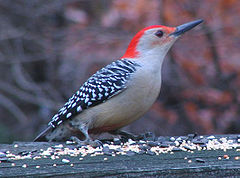
Piciformes
Nine families of largely arboreal birds make up the order Piciformes, the best-known of them being the Picidae, which includes the woodpeckers and close relatives...
Family: Picidae
Picidae
The woodpeckers, piculets and wrynecks are a family, Picidae, of near-passerine birds. Members of this family are found worldwide, except for Australia and New Zealand, Madagascar, and the extreme polar regions...
Woodpeckers are small to medium-sized birds with chisel-like beaks, short legs, stiff tails and long tongues used for capturing insects. Some species have feet with two toes pointing forward, and two backward, while several species have only three toes. Many woodpeckers have the habit of tapping noisily on tree trunks with their beaks. There are 218 species worldwide, 57 in North America and ten in Florida.
- Red-headed WoodpeckerRed-headed WoodpeckerThe Red-headed Woodpecker, Melanerpes erythrocephalus, is a small or medium-sized woodpecker from temperate North America. Their breeding habitat is open country across southern Canada and the eastern-central United States.-Taxonomy:...
, Melanerpes erythrocephalus - Golden-fronted WoodpeckerGolden-fronted WoodpeckerThe Golden-fronted Woodpecker, Melanerpes aurifrons, is a North American woodpecker. Its preferred habitat is mesquite and riparian woodlands. It is distributed from Texas and Oklahoma in the United States through Mexico to Honduras and northern Nicaragua...
, Melanerpes aurifrons (A) - Red-bellied WoodpeckerRed-bellied WoodpeckerThe Red-bellied Woodpecker, Melanerpes carolinus, is a medium-sized woodpecker of the Picidae family. It breeds in southern Canada and the northeastern United States, ranging as far south as Florida and as far west as Texas...
, Melanerpes carolinus - Yellow-bellied SapsuckerYellow-bellied SapsuckerThe Yellow-bellied Sapsucker is a medium-sized woodpecker found in North America, Central America and the Caribbean.-Taxonomy:...
, Sphyrapicus varius - Downy WoodpeckerDowny WoodpeckerThe Downy Woodpecker is a species of woodpecker, the smallest in North America.- Description :Adult Downy Woodpeckers are mainly black on the upperparts and wings, with a white back, throat and belly and white spotting on the wings. There is a white bar above the eye and one below. They have a...
, Picoides pubescens - Hairy WoodpeckerHairy WoodpeckerThe Hairy Woodpecker is a medium-sized woodpecker, averaging approximately 250 mm in length with a 380 mm wingspan...
, Picoides villosus - Red-cockaded WoodpeckerRed-cockaded WoodpeckerThe Red-cockaded Woodpecker is a woodpecker found in southeastern North America.- Description :About the size of the Northern Cardinal, it is approximately 8.5 in. long, with a wingspan of about 14 in. and a weight of about 1.5 ounces...
, Picoides borealis - Northern FlickerNorthern FlickerThe Northern Flicker is a medium-sized member of the woodpecker family. It is native to most of North America, parts of Central America, Cuba, the Cayman Islands, and is one of the few woodpecker species that migrate. There are over 100 common names for the Northern Flicker...
, Colaptes auratus - Pileated WoodpeckerPileated WoodpeckerThe Pileated Woodpecker is a very large North American woodpecker, almost crow-sized, inhabiting deciduous forests in eastern North America, the Great Lakes, the boreal forests of Canada, and parts of the Pacific coast. It is also the largest woodpecker in America.Adults are long, and weigh...
, Dryocopus pileatus - Ivory-billed WoodpeckerIvory-billed WoodpeckerThe Ivory-billed Woodpecker is or was one of the largest woodpeckers in the world, at roughly 20 inches in length and 30 inches in wingspan. It was native to the virgin forests of the southeastern United States...
, Campephilus principalis (e)
Tyrant flycatchers
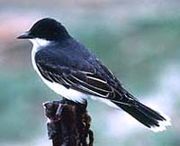
Tyrant flycatchers are passerines which occur throughout North and South America. They superficially resemble the Old World flycatchers, but are more robust with stronger bills. They do not have the sophisticated vocal capabilities of the songbirds. Most, but not all, are rather plain. As the name implies, most are insectivorous. There are 149 in North America and 29 in Florida.
- Elaenia sp.ElaeniaElaenia is a genus of passerine birds in the tyrant flycatcher family which occur in Central and South America. Except by voice, specific identification is often difficult since many species are very similar....
(A) - Olive-sided FlycatcherOlive-sided FlycatcherThe Olive-sided Flycatcher, Contopus cooperi, is a passerine bird. It is a medium-sized tyrant flycatcher.- Description :Adults are dark olive on the face, upperparts and flanks. They have light underparts, a large dark bill and a short tail....
, Contopus cooperi - Western Wood-PeweeWestern Wood PeweeThe Western Wood-Pewee, Contopus sordidulus, is a small tyrant flycatcher. Adults are gray-olive on the upperparts with light underparts, washed with olive on the breast. They have two wing bars and a dark bill with yellow at the base of the lower mandible. This bird is very similar in appearance...
, Contopus sordidulus (A) - Eastern Wood-PeweeEastern Wood PeweeThe Eastern Wood-pewee is a small tyrant flycatcher from North America. This bird and the Western Wood-pewee were formerly considered to be a single species...
, Contopus virens - Cuban Pewee, Contopus cariibaeus (A)
- Yellow-bellied FlycatcherYellow-bellied FlycatcherThe Yellow-bellied Flycatcher is a small insect-eating bird of the tyrant flycatcher family.Adults have brownish-olive upperparts, darker on the wings and tail, with yellowish underparts; they have a white eye ring, white wing bars, a small bill and a short tail...
, Empidonax flaviventris - Acadian FlycatcherAcadian FlycatcherThe Acadian Flycatcher is a small insect-eating bird of the tyrant flycatcher family.- Description :Adults have olive upperparts, darker on the wings and tail, with whitish underparts; they have a white eye ring, white wing bars and a wide bill. The breast is washed with olive. The upper part of...
, Empidonax virescens - Alder FlycatcherAlder FlycatcherThe Alder Flycatcher, Empidonax alnorum, is a small insect-eating bird of the tyrant flycatcher family.Adults have olive-brown upperparts, browner on the wings and tail, with whitish underparts; they have a white eye ring, white wing bars, a small bill and a short tail. The breast is washed with...
, Empidonax alnorum (A) - Willow FlycatcherWillow FlycatcherThe Willow Flycatcher is a small insect-eating bird of the tyrant flycatcher family.Adults have brown-olive upperparts, darker on the wings and tail, with whitish underparts; they have an indistinct white eye ring, white wing bars and a small bill. The breast is washed with olive-grey. The upper...
, Empidonax traillii (A) - Least FlycatcherLeast FlycatcherThe Least Flycatcher , , is a small insect-eating bird...
, Empidonax minimus - Hammond's FlycatcherHammond's FlycatcherHammond's Flycatcher, Empidonax hammondii is a small insect-eating bird. It is a small Empidonax flycatcher, with typical size ranging from 12.5-14.5 cm....
, Empidonax hammondii (A) - Black PhoebeBlack PhoebeThe Black Phoebe, Sayornis nigricans, is a passerine bird in the tyrant-flycatcher family. It breeds from southwest Oregon and California south through Central and South America. It occurs year-round throughout most of its range and migrates less than the other birds in its genus, though its...
, Sayornis nigricans (A) - Eastern PhoebeEastern PhoebeThe Eastern Phoebe is a small passerine bird. This tyrant flycatcher breeds in eastern North America, although its normal range does not include the southeastern coastal USA....
, Sayornis phoebe - Say's PhoebeSay's PhoebeThe Say's Phoebe is a passerine bird in the tyrant flycatcher family.Adults have brownish-gray upperparts with an orange-brown belly and light gray on the throat and breast. Juveniles have cinnamon wing bars; adults have no wing bars....
, Sayornis saya (A) - Vermilion FlycatcherVermilion FlycatcherThe Vermilion Flycatcher is a small passerine bird in the Tyrannidae, or tyrant flycatcher family. Most flycatchers are rather drab, but the Vermilion Flycatcher is a striking exception...
, Pyrocephalus rubinus - Ash-throated FlycatcherAsh-throated FlycatcherThe Ash-throated Flycatcher, Myiarchus cinerascens, is a passerine bird in the tyrant flycatcher family. It breeds in desert scrub, riparian forest, brushy pastures and open woodland from the western United States to central Mexico. It is a short-distance migrant, retreating from most of the U.S....
, Myiarchus cinerascens - Great Crested FlycatcherGreat Crested FlycatcherThe Great Crested Flycatcher is a large insect-eating bird of the tyrant flycatcher family. It is the most widespread member of the genus, Myiarchus, in North America and is found over most of the eastern and mid-western portions of the continent...
, Myiarchus crinitus - Brown-crested FlycatcherBrown-crested FlycatcherThe Brown-crested Flycatcher is a passerine bird in the tyrant flycatcher family. It breeds in open woodland from southern California, southern Nevada, central Arizona, and southern Texas southward to Argentina and Bolivia, and on Trinidad and Tobago...
, Myiarchus tyrannulus - La Sagra' s Flycatcher, Myiarchus sagrae
- Sulphur-bellied FlycatcherSulphur-bellied FlycatcherThe Sulphur-bellied Flycatcher, Myiodynastes luteiventris, is a large Tyrant flycatcher. This bird breeds from southeasternmost Arizona of the United States-, to Costa Rica...
, Myiodynastes luteiventris (A) - Piratic FlycatcherPiratic FlycatcherThe Piratic Flycatcher, Legatus leucophaius, is a passerine bird, the only member of the genus Legatus. It is a resident breeder from southern Mexico and Trinidad south to Bolivia and Argentina...
, Empidonomus leucophaius (A) - Tropical KingbirdTropical KingbirdThe Tropical Kingbird is a large tyrant flycatcher. This bird breeds from southern Arizona and the lower Rio Grande Valley of Texas in the USA through Central America, South America as far as south as central Argentina and western Peru, and on Trinidad and Tobago...
, Tyrannus melancholicus (A) - Cassin's KingbirdCassin's KingbirdThe Cassin's Kingbird, Tyrannus vociferans, is a large Tyrant flycatcher.Adults have a gray head with slightly darker cheeks; a dark unforked tail with a buffy fringe and gray-olive underparts.They have a pale throat and deep yellow lower breast....
, Tyrannus vociferans (A) - Western KingbirdWestern KingbirdThe Western Kingbird is a large tyrant flycatcher.Adults are grey-olive on the upperparts with a grey head and a dark line through the eyes; the underparts are light becoming light orange-yellow on the lower breast and belly. They have a long black tail with white outer feathers...
, Tyrannus verticalis - Eastern KingbirdEastern KingbirdThe Eastern Kingbird, Tyrannus tyrannus, is a large Tyrant flycatcher.Adults are grey-black on the upperparts with light underparts; they have a long black tail with a white end and long pointed wings. They have a red patch on their crown, seldom seen...
, Tyrannus tyrannus - Gray KingbirdGray KingbirdThe Gray Kingbird, also known as Pitirre, Tyrannus dominicensis, is a passerine bird. It breeds from the extreme southeast of the USA through Central America, from Cuba to Puerto Rico as well as eastward towards all across the Lesser West Indies, south to Venezuela, Trinidad, Tobago the Guiana and...
, Tyrannus dominicensis - Loggerhead KingbirdLoggerhead KingbirdThe Loggerhead Kingbird is a species of bird in the Tyrannidae family.It is found in the Bahamas, Cayman Islands, Cuba, the Dominican Republic, Haiti, Jamaica, Puerto Rico, and, very rarely, in the United States....
, Tyrannus caudifasciatus (A) - Scissor-tailed FlycatcherScissor-tailed FlycatcherThe Scissor-tailed Flycatcher is a long-tailed insectivorous bird of the genus, whose members are collectively referred to as kingbirds. The kingbirds are a group of large insectivorous birds in the tyrant flycatcher family...
, Tyrannus forficatus - Fork-tailed FlycatcherFork-tailed FlycatcherThe Fork-tailed Flycatcher, Tyrannus savana, is a passerine bird of the tyrant flycatcher family, and is the member of a genus typically referred to as kingbirds.-Description and ecology:...
, Tyrannus savana
Shrikes
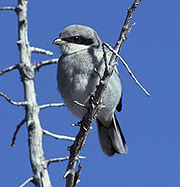
Shrikes are passerines known for their habit of catching other birds and small animals and impaling the uneaten portions of their bodies on thorns. A typical shrike's beak is hooked, like a bird of prey. There are 31 species worldwide, three in North America and one in Florida.
- Loggerhead ShrikeLoggerhead ShrikeThe Loggerhead Shrike is a passerine bird. It is the only member of the shrike family endemic to North America; the related Northern Shrike occurs north of its range but also in the Palearctic....
, Lanius ludovicianus
Vireos
Order: Passeriformes. Family: VireonidaeThe vireos are a group of small to medium-sized passerines restricted to the New World. They are typically greenish in colour and resemble wood warblers apart from their heavier bills. There are 52 species worldwide, 37 in North America and ten in Florida.
- White-eyed VireoWhite-eyed VireoThe White-eyed Vireo, Vireo griseus, is a small songbird. It breeds in the southeastern USA from New Jersey west to northern Missouri and south to Texas and Florida, and also in eastern Mexico, northern Central America, Cuba and the Bahamas....
, Vireo griseus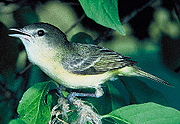
- Thick-billed VireoThick-billed VireoThe Thick-billed Vireo, Vireo crassirostris, is a small songbird. It breeds in the West Indies in the Bahamas, Turks and Caicos Islands, Cayman Islands, Tortuga Island in Haiti and on cays off the coast of Cuba. It occasionally can be found as a vagrant to south Florida in the United States. The...
, Vireo crassirostris (A) - Bell's VireoBell's VireoThe Bell's Vireo is a small North American songbird. It is 4-3/4 to 5 inches in length, dull olive-gray above and whitish below...
, Vireo bellii - Yellow-throated VireoYellow-throated VireoThe Yellow-throated Vireo, Vireo flavifrons, is a small American songbird.Adults are mainly olive on the head and upperparts with a yellow throat and white belly; they have dark eyes with yellow "spectacles". The tail and wings are dark with white wing bars...
, Vireo flavifrons - Blue-headed VireoBlue-headed VireoThe Blue-headed Vireo is a Neotropical migrating song bird found in North and Central America. There are currently two recognized sub-species that belong to the Blue-headed Vireo. It has a range that extends across Canada and the eastern coast of the United-States, Mexico and some of Central America...
, Vireo solitarius - Warbling VireoWarbling VireoThe Warbling Vireo, Vireo gilvus, is a small North American songbird.Its breeding habitat is open deciduous and mixed woods from Alaska to Mexico and the Florida Panhandle. It often nests along streams. It migrates to Mexico and Central America....
, Vireo gilvus - Philadelphia VireoPhiladelphia VireoThe Philadelphia Vireo, Vireo philadelphicus, is a small songbird.Adults are mainly olive-brown on the upperparts with yellow underparts; they have dark eyes and a grey crown. There is a dark line through the eyes and a white stripe just over them. They have thick blue-grey legs and a stout...
, Vireo philadelphicus - Red-eyed VireoRed-eyed VireoThe Red-eyed Vireo, Vireo olivaceus, is a small American songbird, 13–14 cm in length. It is somewhat warbler-like but not closely related to the New World warblers...
, Vireo olivaceus - Yellow-green VireoYellow-green VireoThe Yellow-green Vireo, Vireo flavoviridis, is a small passerine bird. It breeds from southern Texas in the United States and the western and eastern mountain ranges of northern Mexico south to central Panama...
, Vireo flavoviridis (A) - Black-whiskered VireoBlack-whiskered VireoThe Black-whiskered Vireo, Vireo altiloquus, is a small passerine bird, which breeds in southern Florida, USA, and the West Indies as far south as the offshore islands of Venezuela. It is a partial migrant, with northern birds wintering from the Greater Antilles to northern South America...
, Vireo altiloquus
Jays, crows, magpies, and ravens
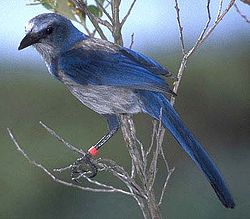
Corvidae
Corvidae is a cosmopolitan family of oscine passerine birds that contains the crows, ravens, rooks, jackdaws, jays, magpies, treepies, choughs and nutcrackers. The common English names used are corvids or the crow family , and there are over 120 species...
The Corvidae family includes crows, ravens, jays, choughs, magpies, treepies, nutcrackers, and ground jays. Corvids are above average in size for the bird order Passeriformes. Some of the larger species show levels of learned behavior of a high degree. There are 120 species worldwide, 40 in North America and four in Florida.
- Blue JayBlue JayThe Blue Jay is a passerine bird in the family Corvidae, native to North America. It is resident through most of eastern and central United States and southern Canada, although western populations may be migratory. It breeds in both deciduous and coniferous forests, and is common near and in...
, Cyanocitta cristata - Florida Scrub-Jay, Aphelocoma coerulescens
- American CrowAmerican CrowThe American Crow is a large passerine bird species of the family Corvidae. It is a common bird found throughout much of North America...
, Corvus brachyrhynchos - Fish CrowFish CrowThe Fish Crow is a species of crow that is associated with wetland habitats in the eastern and southeastern United States.-Taxonomy:The Fish Crow was first described by Alexander Wilson in 1812...
, Corvus ossifragus
Larks
Order: Passeriformes. Family: AlaudidaeLarks are small terrestrial birds with often extravagant songs and display flights. Most larks are fairly dull in appearance. Their food is insects and seeds. There are 91 species worldwide, two in North America and one in Florida species.
- Horned Lark, Eremophila alpestris
Swallows and martins

The Hirundinidae family is a group of passerines characterised by their adaptation to aerial feeding. Their adaptations include a slender streamlined body, long pointed wings and a short bill with a wide gape. The feet are designed for perching rather than walking, and the front toes are partly joined at the base. There are 75 species worldwide, 22 in North America and eleven in Florida.
- Purple MartinPurple MartinThe Purple Martin is the largest North American swallow. These aerial acrobats have speed and agility in flight, and when approaching their housing, will dive from the sky at great speeds with their wings tucked.-Description and taxonomy:...
, Progne subis - Cuban MartinCuban MartinThe Cuban Martin, Progne cryptoleuca, is a large swallow endemic to Cuba.It is closely related to the Caribbean Martin, P. dominicensis which breeds on Caribbean islands from Jamaica east to Tobago, and the P. d...
, Progne cryptoleuca (A) - Southern MartinSouthern MartinThe Southern Martin is a species of bird in the Hirundinidae family.It is found in Argentina, Bolivia, Brazil, Colombia, Ecuador, Panama, Paraguay, Peru, and Uruguay....
, Progne elegans (A) - Tree SwallowTree SwallowThe Tree Swallow, Tachycineta bicolor, is a migratory passerine bird that breeds in North America and winters in Mexico, Central America and the Caribbean. It is a very rare vagrant to western Europe....
, Tachycineta bicolor - Mangrove SwallowMangrove SwallowThe Mangrove Swallow, Tachycineta albilinea, is a passerine bird that breeds in coastal regions from Mexico through Central America to Panama. It is non-migratory, but may make seasonal movements....
, Tachycineta albilinea (A) - Bahama SwallowBahama SwallowThe Bahama Swallow is a swallow found only in the Bahamas.-Physical description:This glossy Tachycineta swallow has a green head and back, blue upper wings, a black tail and wingtips, and a white belly and chin....
, Tachycineta cyaneovirdis (A) - Northern Rough-winged SwallowNorthern Rough-winged SwallowThe Northern Rough-winged Swallow is a small swallow.Adults are 13–15 cm in length, brown on top with light underparts and a forked tail. They are similar in appearance to the Bank Swallow but have a dusky throat and breast...
, Stelgidopteryx serripennis - Bank Swallow, Riparia riparia
- Cliff SwallowCliff SwallowThe Cliff Swallow is a member of the passerine bird family Hirundinidae — the swallows and martins.It breeds in North America, and is migratory, wintering in western South America from Venezuela southwards to northeast Argentina...
, Petrochelidon pyrrhonota - Cave SwallowCave SwallowThe Cave Swallow, Petrochelidon fulva, is a medium-sized, squarish tailed swallow belonging to the same genus as the more familiar and widespread Cliff Swallow of North America...
, Petrochelidon fulva - Barn SwallowBarn SwallowThe Barn Swallow is the most widespread species of swallow in the world. It is a distinctive passerine bird with blue upperparts, a long, deeply forked tail and curved, pointed wings. It is found in Europe, Asia, Africa and the Americas...
, Hirundo rustica
Chickadees and titmice
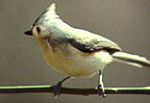
The Paridae are mainly small stocky woodland species with short stout bills. Some have crests. They are adaptable birds, with a mixed diet including seeds and insects. There are 59 species worldwide, 12 in North America and two in Florida.
- Carolina ChickadeeCarolina ChickadeeThe Carolina Chickadee, Poecile carolinensis, is a small passerine bird in the tit family Paridae. Often, it is still placed in the genus Parus with most other tits, but mtDNA cytochrome b sequence data and morphology suggest that separating Poecile more adequately expresses these birds'...
, Poecile carolinensis - Tufted TitmouseTufted TitmouseThe Tufted Titmouse, Baeolophus bicolor, is a small songbird from North America, a species in the tit and chickadee family . The Black-crested Titmouse, found from central and southern Texas southwards, was included as a subspecies but is now considered a separate species B...
, Baeolophus bicolor
Nuthatches

Sittidae
Sittidae is a family of small passerine birds which contains the single genus Sitta containing about 24 species of nuthatches, which are found across Eurasia and North America....
Nuthatches are small woodland birds. They have the unusual ability to climb down trees head first, unlike most other birds which can only go upwards. Nuthatches have big heads, short tails and powerful bills and feet. There are 24 species worldwide, four in North America and three in Florida.
- Red-breasted NuthatchRed-breasted NuthatchThe Red-breasted Nuthatch, Sitta canadensis, is a small songbird. The adult has blue-grey upperparts with cinnamon underparts, a white throat and face with a black stripe through the eyes, a straight grey bill and a black crown. Its call, which has been likened to a tin trumpet, is high-pitched...
, Sitta canadensis - White-breasted NuthatchWhite-breasted NuthatchThe White-breasted Nuthatch is a small songbird of the nuthatch family which breeds in old-growth woodland across much of temperate North America. It is a stocky bird, with a large head, short tail, powerful bill and strong feet. The upperparts are pale blue-gray, and the face and underparts are...
, Sitta carolinensis - Brown-headed NuthatchBrown-headed NuthatchThe Brown-headed Nuthatch, Sitta pusilla, is a small songbird found in pine forests throughout the Southeastern United States. An endangered population occurs in the pineyards of Grand Bahama; some authorities consider it to represent a separate species, S. insularis...
, Sitta pusilla
Treecreepers
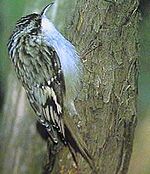
Treecreepers are small woodland birds, brown above and white below. They have thin pointed down-curved bills, which they use to extricate insects from bark. They have stiff tail feathers, like woodpeckers, which they use to support themselves on vertical trees. There are six species worldwide, with one in North America.
- Brown CreeperBrown Creeper-Description:Adults are brown on the upperparts with light spotting, resembling a piece of tree bark, with white underparts. They have a long thin bill with a slight downward curve and a long tail. The male creeper has a slightly larger bill than the female...
, Certhia americana
Wrens
Order: Passeriformes. Family: TroglodytidaeWrens are small and inconspicuous birds, except for their loud songs. They have short wings and a thin down-turned bill. Several species often hold their tails upright. All are insectivorous. There are 79 species worldwide, 46 in North America and seven in Florida.
- Rock WrenRock WrenThe Rock Wren is a small songbird of the wren family. It is the only species in the genus Salpinctes.The 12 cm long adults have grey-brown upperparts with small black and white spots and pale grey underparts with a light brown rump...
, Salpinctes obsoletus (A)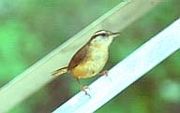
- Carolina WrenCarolina WrenThe Carolina Wren is a common species of wren, resident in the eastern half of the USA, the extreme south of Ontario, Canada, and the extreme northeast of Mexico...
, Thryothorus ludovicianus - Bewick's WrenBewick's WrenThe Bewick's Wren is a wren native to North America. At about 14 cm long, it is grey-brown above, white below, with a long white eyebrow. While similar in appearance to the Carolina Wren, it has a long tail that is tipped in white. The song is loud and melodious, much like the song of other...
, Thryomanes bewickii (A) - House WrenHouse WrenThe House Wren, Troglodytes aedon, is a very small songbird of the wren family, Troglodytidae. It occurs from Canada to southernmost South America, and is thus the most widely distributed bird in the Americas. It occurs in most suburban areas in its range and it is the single most common wren...
, Troglodytes aedon - Winter WrenWinter WrenThe Winter Wren is a very small North American bird and a member of the mainly New World wren family Troglodytidae. It was once lumped with Troglodytes pacificus of western North America and Troglodytes troglodytes of Eurasia under the name Winter Wren.It breeds in coniferous forests from British...
, Troglodytes hyemalis - Sedge WrenSedge WrenThe Sedge Wren, Cistothorus platensis, is a small songbird of the Wren family. It was formerly known as the Short-billed Marsh Wren, and in South America is known as the Grass Wren. There are about 20 different subspecies which are found across most of the Americas...
, Cistothorus platensis - Marsh WrenMarsh WrenThe Marsh Wren is a small North American songbird of the wren family. It is sometimes called Long-billed Marsh Wren to distinguish it from the Sedge Wren, also known as Short-billed Marsh Wren....
, Cistothorus palustris
Bulbuls
Order: Passeriformes. Family: PycnonotidaeBulbul
Bulbuls are a family, Pycnonotidae, of medium-sized passerine songbirds. Many forest species are known as greenbuls. The family is distributed across most of Africa and into the Middle East, tropical Asia to Indonesia, and north as far as Japan. A few insular species occur on the tropical islands...
The bulbuls are a family of medium-sized songbird
Songbird
A songbird is a bird belonging to the suborder Passeri of the perching birds . Another name that is sometimes seen as scientific or vernacular name is Oscines, from Latin oscen, "a songbird"...
s native to Africa
Africa
Africa is the world's second largest and second most populous continent, after Asia. At about 30.2 million km² including adjacent islands, it covers 6% of the Earth's total surface area and 20.4% of the total land area...
and tropical Asia
Asia
Asia is the world's largest and most populous continent, located primarily in the eastern and northern hemispheres. It covers 8.7% of the Earth's total surface area and with approximately 3.879 billion people, it hosts 60% of the world's current human population...
. They are noisy and gregarious and often have beautiful songs. There are 130 species worldwide, two in North America and one in Florida.
- Red-whiskered BulbulRed-whiskered BulbulThe Red-whiskered Bulbul is a passerine bird found in Asia. It is a member of the bulbul family. It is a resident frugivore found mainly in tropical Asia. It has been introduced in many tropical areas of the world where populations have established themselves...
, Pycnonotus jocosus (I)
Gnatcatchers
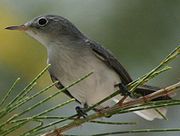
The family Polioptilidae is a group of small insectivorous passerine birds, containing the gnatcatchers and gnatwrens. There are ten North American species, with one in Florida.
- Blue-gray GnatcatcherBlue-gray GnatcatcherThe Blue-gray Gnatcatcher, Polioptila caerulea, is a very small songbird.Adult males are blue-grey on the upperparts with white underparts and have a long slender bill, long black tail and an angry black unibrow. Females are less blue without the unibrow...
, Polioptila caerulea
Kinglets
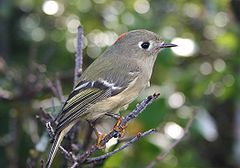
The kinglets are a small family of birds which resemble the titmice. They are very small insectivorous birds in the genus Regulus. The adults have colored crowns, giving rise to their name. There are five species worldwide, two in North America and two in Florida.
- Golden-crowned KingletGolden-crowned KingletThe Golden-crowned Kinglet, Regulus satrapa, is a very small songbird.Adults are olive-gray on the upperparts with white underparts, with thin bills and short tails. They have white wing bars, a black stripe through the eyes and a yellow crown surrounded by black...
, Regulus satrapa - Ruby-crowned Kinglet, Regulus calendula
Thrushes
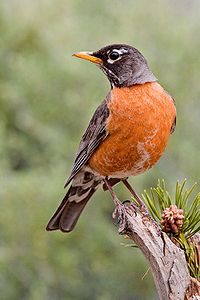
The Thrushes are a group of passerine birds that occur mainly but not exclusively in the Old World. They are plump, soft plumaged, small to medium-sized insectivores or sometimes omnivores, often feeding on the ground. Many have attractive songs. There are 335 species worldwide, 60 in North America and 13 in Florida.
- Northern WheatearNorthern WheatearThe Northern Wheatear or Wheatear is a small passerine bird that was formerly classed as a member of the thrush family Turdidae, but is now more generally considered to be an Old World flycatcher, Muscicapidae...
, Oenanthe oenanthe (A) - Eastern BluebirdEastern BluebirdThe Eastern Bluebird, Sialia sialis, is a small thrush found in open woodlands, farmlands and orchards, and most recently can be spotted in suburban areas. It is the state bird of Missouri and New York....
, Sialia sialis - Mountain BluebirdMountain BluebirdThe Mountain Bluebird is a medium-sized bird weighing about 2-5 ounces, with a length from 15–20 cm . They have light underbellies and black eyes. Adult males have thin bills are bright turquoise-blue and somewhat lighter beneath. Adult females have duller blue wings and tail, grey breast,...
, Sialia currucoides (A) - Townsend's SolitaireTownsend's SolitaireTownsend's Solitaire is a medium-sized thrush, the only solitaire native to America north of Mexico.-Range and habitat:...
, Myadestes townsendi (A) - VeeryVeeryThe Veery, Catharus fuscescens, is a small thrush species. It is occasionally called Willow Thrush or Wilson's Thrush. It is a member of a close-knit group of migrant Catharus species, which also includes the cryptotaxa Grey-cheeked Thrush and Bicknell's Thrush The Veery, Catharus fuscescens, is a...
, Catharus fuscescens - Gray-cheeked ThrushGray-cheeked ThrushThe Grey-cheeked Thrush, Catharus minimus, is a medium-sized thrush. This species is 15–17 cm in length, and has the white-dark-white underwing pattern characteristic of Catharus thrushes. It is a member of a close-knit group of migrant species together with the Veery and Bicknell's Thrush ;...
, Catharus minimus - Bicknell's ThrushBicknell's ThrushThe Bicknell's Thrush, Catharus bicknelli, is a medium-sized thrush, at 17.5 cm and 28 g . It was named after Eugene Bicknell, an American amateur ornithologist, who discovered the species on Slide Mountain in the Catskills in the late 19th century.Adults are olive-brown on the upperparts,...
, Catharus bicknelli (A) - Swainson's ThrushSwainson's ThrushSwainson's Thrush , also called Olive-backed Thrush, is a medium-sized thrush. This species is 16–18 cm in length, and has the white-dark-white underwing pattern characteristic of Catharus thrushes...
, Catharus ustulatus - Hermit ThrushHermit ThrushThe Hermit Thrush is a medium-sized North American thrush. It is not very closely related to the other North American migrant species of Catharus, but rather to the Mexican Russet Nightingale-thrush.-Description:...
, Catharus guttatus - Wood ThrushWood ThrushThe Wood Thrush, Hylocichla mustelina, is a North American passerine bird. It is closely related to other thrushes such as the American Robin and is widely distributed across North America, wintering in Central America and southern Mexico...
, Hylocichla mustelina - American RobinAmerican RobinThe American Robin or North American Robin is a migratory songbird of the thrush family. It is named after the European Robin because of its reddish-orange breast, though the two species are not closely related, with the European robin belonging to the flycatcher family...
, Turdus migratorius - Red-legged ThrushRed-legged ThrushThe Red-legged Thrush is a species of bird in the Turdidae family.It is found in the Bahamas, Cayman Brac, Cuba, Dominica, the Dominican Republic, Haiti and Puerto Rico...
, Turdus plumbeus (A) - Varied ThrushVaried ThrushThe Varied Thrush is a member of the thrush family Turdidae.It breeds in western North America from Alaska to northern California. It is migratory, with northern breeders moving south within or somewhat beyond the breeding range...
, Ixoreus naevius (A)
Mimids
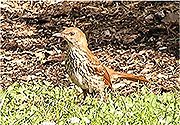
The Mimids are a family of passerine birds that includes thrashers, mockingbirds, tremblers, and the New World catbirds. They are notable for their vocalization, especially their remarkable ability to mimic a wide variety of birds and other sounds heard outdoors. The species tend towards dull grays and browns in their appearance. There are 35 species worldwide, 24 in North America and six in Florida.
- Gray CatbirdGray CatbirdThe Gray Catbird , also spelled Grey Catbird, is a medium-sized northern American perching bird of the mimid family. It is the only member of the "catbird" genus Dumetella...
, Dumetella carolinensis - Northern MockingbirdNorthern MockingbirdThe Northern Mockingbird, Mimus polyglottos, is the only mockingbird commonly found in North America. This species was first described by Linnaeus in his Systema naturae in 1758 as Turdus polyglottos....
, Mimus polyglottos See picture at top of article. - Bahama MockingbirdBahama MockingbirdThe Bahama Mockingbird is a species of bird in the Mimidae family.It is found in the Bahamas, Cuba, Jamaica and the Turks and Caicos Islands, and is a vagrant to the United States....
, Mimus gundlachii - Sage ThrasherSage ThrasherThe Sage Thrasher is a medium-sized passerine bird from the family Mimidae, which also includes mockingbirds, tremblers and New World catbirds. It is the only member of the genus Oreoscoptes. This seems less close to the Caribbean thrashers, but rather to the mockingbirds instead .O...
, Oreoscoptes montanus (A) - Brown ThrasherBrown ThrasherThe Brown Thrasher , sometimes erroneously called the Brown Thrush, is a bird in the Mimidae family, a group that also includes the New World catbirds and mockingbirds.-Description:...
, Toxostoma rufum - Curve-billed ThrasherCurve-billed ThrasherThe Curve-billed Thrasher is a perching bird of the thrasher group native to the southwestern United States and much of Mexico....
, Toxostoma curvirostre (A)
Starlings and mynas
Order: Passeriformes. Family: SturnidaeStarlings are small to medium-sized passerines with strong feet. Their flight is strong and direct, and they are very gregarious. Their preferred habitat is open country, and they eat insects and fruit. Their plumage is typically dark with a metallic sheen. There are 125 species worldwide, three in North America and two in Florida.
- European StarlingEuropean StarlingThe Common Starling , also known as the European Starling or just Starling, is a passerine bird in the family Sturnidae.This species of starling is native to most of temperate Europe and western Asia...
, Sturnus vulgaris (I) - Common MynaCommon MynaThe Common Myna or Indian Myna also sometimes spelled Mynah, is a member of family Sturnidae native to Asia. An omnivorous open woodland bird with a strong territorial instinct, the Myna has adapted extremely well to urban environments...
, Acridotheres tristis (I)
Pipits
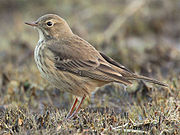
Motacillidae
The Motacillidae are a family of small passerine birds with medium to long tails. There are around 65 species in 6 genera and they include the wagtails, longclaws and pipits. The longclaws are entirely restricted to the Afrotropics, and the wagtails are predominately found in Europe, Africa and...
The Motacillidae are a family of small passerine birds with medium to long tails. They include the wagtails, longclaws and pipits. They are slender, ground-feeding insectivores of open country. There are 64 species worldwide, 11 in North America and three in Florida.
- White WagtailWhite Wagtail"Pied Wagtail" redirects here. For the related African bird, see African Pied Wagtail.The White Wagtail is a small passerine bird in the wagtail family Motacillidae, which also includes the pipits and longclaws. This species breeds in much of Europe and Asia and parts of north Africa...
, Motacilla alba (A) - American PipitBuff-bellied PipitThe Buff-bellied Pipit , or American Pipit as it is known in North America, is a small songbird found on both sides of the northern Pacific. It was first described by Marmaduke Tunstall in his 1771 Ornithologia Britannica...
, Anthus rubescens - Sprague's PipitSprague's PipitSprague's Pipit is a small passerine bird that breeds in the short and mixed-grass prairies of North America and overwinters in the southwestern United States and northern Mexico. Easiest to identify by the distinctive descending call that is delivered in the breeding season from a considerable...
, Anthus spragueii
Waxwings
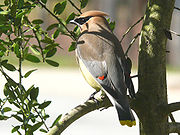
The waxwings are a group of passerine birds characterised by soft silky plumage and unique red tips to some of the wing feathers. In the Bohemian and Cedar Waxwings, these tips look like sealing wax, and give the group its name. These are arboreal birds of northern forests. They live on insects in summer and berries in winter. There are three species worldwide, two in North America and one in Florida.
- Cedar WaxwingCedar WaxwingThe Cedar Waxwing is a member of the family Bombycillidae or waxwing family of passerine birds. It breeds in open wooded areas in North America, principally southern Canada and the northern United States.-Description:...
, Bombycilla cedrorum
Longspurs
Order: Passeriformes. Family: CalcariidaeCalcariidae
The Calcariidae -commonly known as longspurs or snow buntings- are a small family of passerine birds. There are 3 genera and 6 species worldwide.- Taxonomy :...
The Calcariidae are a group of passerine birds that have been traditionally grouped with the Emberizeridae (New World Sparrows), but differe in a number of respects, and are usually found in open grassy areas. There are six North American species, with three in Florida.
- Lapland Longspur, Calcarius lapponicus
- Chestnut-collared LongspurChestnut-collared LongspurThe Chestnut-collared Longspur, Calcarius ornatus, is a small ground-feeding bird from the family Calcariidae which also contains the longspurs.-Overview:...
, Calcarius ornatus (A) - Snow BuntingSnow BuntingThe Snow Bunting , sometimes colloquially called a snowflake, is a passerine bird in the longspur family Calcariidae. It is an arctic specialist, with a circumpolar Arctic breeding range throughout the northern hemisphere...
, Plectrophenax nivalis
Wood-warblers
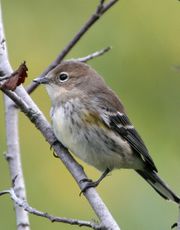
The Wood Warblers are a group of small, often colorful, passerines restricted to the New World. Most are arboreal, but some are terrestrial. Most members of this family are insectivores. There are 119 species world wide, 88 in North America and 43 in Florida.
- Bachman's WarblerBachman's WarblerThe Bachman's Warbler, Vermivora bachmanii, is a small passerine bird that inhabits the swamps and lowland forests of the southeast United States. This warbler is a migrant, wintering in Cuba. The Bachman’s Warbler is small for a warbler and is unique for its thin and decurved bill. It has strong...
, Vermivora bachmannii (E) - Blue-winged WarblerBlue-winged WarblerThe Blue-winged Warbler, Vermivora cyanoptera, is a fairly common New World warbler, 11.5 cm long and weighing 8.5 g. It breeds in eastern North America in southern Ontario and the eastern USA. Its range is extending northwards, where it is replacing the very closely related...
, Vermivora cyanoptera - Golden-winged WarblerGolden-winged WarblerThe Golden-winged Warbler, Vermivora chrysoptera, is a New World warbler, 11.6 cm long and weighing 8.5 g. It breeds in eastern North America, southeastern Canada and the eastern USA...
, Vermivora chrysoptera - Tennessee WarblerTennessee WarblerThe Tennessee Warbler, Oreothlypis peregrina, is a New World warbler. It breeds in northern North America across Canada and the northern USA. It is migratory, wintering in southern Central America and northern Colombia and Venezuela, with a few stragglers going as far south as Ecuador. It is a...
, Oreothlypis peregrina - Orange-crowned WarblerOrange-crowned WarblerThe Orange-crowned Warbler is a small songbird of the New World warbler family.These birds are distinguished by their lack of wing bars, streaking on the underparts, strong face marking or bright colouring, resembling a fall Tennessee Warbler. The orange patch on the crown is usually not visible...
, Oreothlypis celata - Nashville WarblerNashville WarblerThe Nashville Warbler, Vermivora ruficapilla, is a small songbird in the New World warbler family.They have olive-brown upperparts, a white belly and a yellow throat and breast; they have a white eye ring, no wing bars and a thin pointed bill. Adult males have a grey head with a rusty crown patch ;...
, Oreothlypis ruficapilla - Northern ParulaNorthern ParulaThe Northern Parula, Parula americana, is a small New World warbler. It breeds in eastern North America from southern Canada to Florida....
, Parula americana - Yellow WarblerYellow WarblerDendroica petechia is a New World warbler species or superspecies; the subspecies group around D. aestiva is increasingly treated as good species Dendroica aestiva again. The name for the entire cryptic species complex is Mangrove Warbler, and another group of subspecies is known as Golden Warbler...
, Dendroica petechia - Chestnut-sided WarblerChestnut-sided WarblerThe Chestnut-sided Warbler is a New World warbler. They breed in eastern North America and in southern Canada westwards to the Canadian Prairies...
, Dendroica pensylvanica - Magnolia WarblerMagnolia WarblerSetophaga magnolia, commonly known as the Magnolia warbler, is a member of the Parulidae family of wood warblers. [4] This warbler was first discovered in magnolia trees in the 19th century by famed ornithologist Alexander Wilson while in Mississippi. [7]-Description:The magnolia warbler can be...
, Dendroica magnolia - Cape May WarblerCape May WarblerThe Cape May Warbler, Dendroica tigrina, is a small New World warbler. It breeds in northern North America. Its breeding habitat spans across all but the westernmost parts of southern Canada, and into the Great Lakes region and New England. It is migratory, wintering in the West Indies...
, Dendroica tigrina - Black-throated Blue WarblerBlack-throated Blue WarblerThe Black-throated Blue Warbler, Setophaga caerulescens, is a small songbird of the New World warbler family.Adult males have white underparts with black throat, face and flanks; the upperparts are deep blue; immature males are similar with upperparts more greenish...
, Dendroica caerulescens - Yellow-rumped WarblerMyrtle WarblerThe Myrtle Warbler is a small New World warbler.This passerine bird was long known to be closely related to its western counterpart, Audubon's Warbler, and at various times the two forms have been classed as separate species or grouped as Yellow-rumped Warblers, Dendroica coronata...
, Dendroica coronata- "Audubon's WarblerAudubon's WarblerThe Audubon's Warbler, Dendroica coronata auduboni, is a small New World warbler.This passerine bird was long known to be closely related to its eastern counterpart, the Myrtle Warbler, and at various times the two forms have been classed as separate species or grouped as the Yellow-rumped Warbler,...
", Dendroica coronata auduboni (A)
- "Audubon's Warbler
- Black-throated Gray WarblerBlack-throated Gray WarblerThe Black-throated Gray Warbler is a songbird of the New World warbler family. It is 13 cm long and has black, grey, and white plumage. It breeds in western North America from British Columbia to New Mexico, and winters in Mexico and the southwestern United States...
, Dendroica nigrescens - Golden-cheeked WarblerGolden-cheeked WarblerThe Golden-cheeked Warbler Dendroica chrysoparia is an endangered species of bird that breeds in Central Texas, from Palo Pinto County southwestward along the eastern and southern edge of the Edwards Plateau to Kinney County...
, Dendroica chrysoparia (A) - Black-throated Green WarblerBlack-throated Green WarblerThe Black-throated Green Warbler, Setophaga virens, is a small songbird of the New World warbler family.It is 12 cm long and weighs 9 g, and has an olive-green crown, a yellow face with olive markings, a thin pointed bill, white wing bars, an olive-green back and pale underparts with...
, Dendroica virens - Townsend's WarblerTownsend's WarblerThe Townsend's Warbler, Dendroica townsendi, is a small songbird of the New World warbler family.These birds have a yellow face with a black stripe across their cheeks, a thin pointed bill, white wing bars, olive upperparts with black streaks on their backs and flanks, and a white belly...
, Dendroica townsendi - Blackburnian WarblerBlackburnian WarblerThe Blackburnian Warbler, Dendroica fusca , is a small New World warbler. They breed in eastern North America, from southern Canada, westwards to the southern Canadian Prairies, the Great Lakes region and New England, to North Carolina....
, Dendroica fusca - Yellow-throated WarblerYellow-throated WarblerThe Yellow-throated Warbler, Dendroica dominica, is a small migratory songbird species breeding in temperate North America. It belongs to the New World warbler family .-Description:...
, Dendroica dominica - Pine WarblerPine WarblerThe Pine Warbler, Dendroica pinus, is a small songbird of the New World warbler family.These birds have white bellies, white wing bars, dark legs and thin, relatively long pointed bills; they have yellowish lines over their eyes. Adult males have olive upperparts and bright yellow throats and...
, Dendroica pinus - Kirtland's WarblerKirtland's WarblerKirtland's Warbler is a small songbird of the New World warbler family , named after Jared P. Kirtland, an Ohio doctor and amateur naturalist. Nearly extinct just 50 years ago, it is well on its way to recovery. It requires large areas of dense young jack pine for its breeding habitat...
, Dendroica kirtlandii (A) - Prairie WarblerPrairie WarblerThe Prairie Warbler, Dendroica discolor, is a small songbird of the New World warbler family.These birds have yellow underparts with dark streaks on the flanks, and olive upperparts with rusty streaks on the back; they have a yellow line above the eye, a dark line through it, and a yellow spot...
, Dendroica discolor - Palm WarblerPalm WarblerThe Palm Warbler, Dendroica palmarum, is a small songbird of the New World warbler family.The species comprises two distinct subspecies that may merit specific status....
, Dendroica palmarum - Bay-breasted WarblerBay-breasted WarblerThe Bay-breasted Warbler, Dendroica castanea , is a New World warbler. They breed in northern North America, specifically in Canada, into the Great Lakes region, and into northern New England....
, Dendroica castanea - Blackpoll WarblerBlackpoll WarblerThe Blackpoll Warbler, Dendroica striata , is a New World warbler. Breeding males are mostly black and white. They have a prominent black cap, white cheeks and white wing bars. The Blackpoll breeds in northern North America, from Alaska, through most of Canada, and into the Great Lakes region and...
, Dendroica striata - Cerulean WarblerCerulean WarblerThe Cerulean Warbler, Dendroica cerulea, is a small songbird of the New World warbler family.-Description:Adult males have pale cerulean blue upperparts and white underparts with a black necklace across the breast; they also have black streaks on the back and flanks...
, Dendroica cerulea - Black-and-white WarblerBlack-and-white WarblerThe Black-and-white Warbler is a small New World warbler. It breeds in northern and eastern North America from southern Canada to Florida....
, Mniotilta varia - American RedstartAmerican RedstartThe American Redstart is a New World warbler. It is the only member of its genus and is unrelated to the Old World redstarts. It derives its name from the male's red tail, start being an old word for tail.-Description:...
, Setophaga ruticilla - Prothonotary WarblerProthonotary WarblerThe Prothonotary Warbler is a small songbird of the New World warbler family. It is the only member of the genus Protonotaria....
, Protonotaria citrea - Worm-eating WarblerWorm-eating WarblerThe Worm-eating Warbler is a small New World warbler. It is the only species classified in the genus Helmitheros....
, Helmitheros vermivorus - Swainson's WarblerSwainson's WarblerSwainson's Warbler, Limnothlypis swainsonii, is a small species of New World warbler. It is monotypic, the only member of the genus Limnothlypis.-Description:...
, Limnothlypis swainsonii - OvenbirdOvenbirdThe Ovenbird is a small songbird of the New World warbler family . This migratory bird breeds in eastern North America and moves south in winter.-Taxonomy:...
, Seiurus aurocapilla - Northern WaterthrushNorthern WaterthrushThe Northern Waterthrush is one of the larger New World warblers. It breeds in the northern part of North America in Canada, and in the northern United States, . This bird is migratory, wintering in Central America, the West Indies, and Florida; also Venezuela, Colombia, and Ecuador...
, Parkesia noveboracensis - Louisiana WaterthrushLouisiana WaterthrushThe Louisiana Waterthrush is a New World warbler. It breeds in eastern North America from southernmost Canada and south through the eastern USA, excluding Florida and the coast....
, Parkesia motacilla - Kentucky WarblerKentucky WarblerThe Kentucky Warbler, Oporornis formosus, is a small species of New World warbler. The Kentucky Warbler, like all members of the genus Oporornis, is a sluggish and heavy warbler with a short tail, preferring to spend most of its time on or near the ground, except when singing.Adult Kentucky...
, Oporornis formosus - Connecticut WarblerConnecticut WarblerThe Connecticut Warbler Oporornis agilis is a small songbird of the New World warbler family.These 15 cm long birds have light yellow underparts and olive upperparts; they have a light eye ring, pink legs, a long tail, pale wing bars and a thin pointed bill...
, Oporornis agilis - Mourning WarblerMourning WarblerThe Mourning Warbler, Oporornis philadelphia, is a small songbird of the New World warbler family.These 13 cm long birds have yellow underparts, olive-green upperparts and pink legs. Adult males have a grey hood and a black patch on the throat and breast...
, Oporornis philadelphia - MacGillivray's WarblerMacGillivray's WarblerThe MacGillivray's Warbler, Oporornis tolmiei, is a small species of New World warbler. Like all members of the genus Oporornis, these birds are sluggish and heavy warblers with short tails, preferring to spend most of their time on, or near the ground, except when singing.The MacGillivray's...
, Oporornis tolmiei (A) - Common YellowthroatCommon YellowthroatThe Common Yellowthroat is a New World warbler. They are abundant breeders in North America, ranging from southern Canada to central Mexico....
, Geothlypis trichas - Hooded WarblerHooded WarblerThe Hooded Warbler, Wilsonia citrina, is a New World warbler. It breeds in eastern North America and across the eastern USA and into southernmost Canada, . It is migratory, wintering in Central America and the West Indies...
, Wilsonia citrina - Wilson's WarblerWilson's WarblerThe Wilson's Warbler, Wilsonia pusilla, is a small New World warbler. It is primarily greenish above and yellow below, with rounded wings and a long, slim tail. The male has a black crown patch which is greatly reduced or missing entirely in the female...
, Wilsonia pusilla - Canada WarblerCanada WarblerThe Canada Warbler is a small 13 cm long songbird of the New World warbler family.These birds have yellow underparts, blue-grey upperparts and pink legs; they also have yellow eye-rings and thin, pointed bills. Adult males have black foreheads and black necklaces...
, Wilsonia canadensis - Yellow-breasted ChatYellow-breasted ChatThe Yellow-breasted Chat is a large songbird, formerly considered the most atypical member of the New World warbler family, though the long-standing suspicion is that it does not actually belong there. Its placement is not definitely resolved. It is the only member of the genus Icteria...
, Icteria virens
Bananaquit

Family: Coerebidae (Incertae sedis
Incertae sedis
, is a term used to define a taxonomic group where its broader relationships are unknown or undefined. Uncertainty at specific taxonomic levels is attributed by , , and similar terms.-Examples:*The fossil plant Paradinandra suecica could not be assigned to any...
)
The Bananaquit is a small passerine bird. It has a slender, curved bill, adapted to taking nectar from flowers, and is the only member of the genus Coereba (Vieillot, 1809). It is normally placed within the monotypic
Monotypic
In biology, a monotypic taxon is a taxonomic group with only one biological type. The term's usage differs slightly between botany and zoology. The term monotypic has a separate use in conservation biology, monotypic habitat, regarding species habitat conversion eliminating biodiversity and...
family Coerebidae, although there is uncertainty whether that placement is correct (hence the assignment Genus: Coereba Incertae sedis
Incertae sedis
, is a term used to define a taxonomic group where its broader relationships are unknown or undefined. Uncertainty at specific taxonomic levels is attributed by , , and similar terms.-Examples:*The fossil plant Paradinandra suecica could not be assigned to any...
).
- BananaquitBananaquitThe Bananaquit is a species of passerine bird of uncertain relation. It is tentatively placed in the tanager family, but classified as incertae sedis by other authorities such as the American Ornithologists' Union. Its classification is debated, and it is often placed in its own family: Coerebidae...
, Coereba flaveola
Tanagers
Order: Passeriformes. Family: ThraupidaeThe tanagers are a large group of small to medium-sized passerine birds restricted to the New World, mainly in the tropics. Many species are brightly colored. They are seedeaters, but their preference tends towards fruit and nectar. Most have short, rounded wings. There are 57 in North America, with one in Florida.
- Western SpindalisWestern SpindalisThe Western Spindalis , formerly called the Stripe-headed Tanager, is a songbird species. S. zena formerly included other species of spindalis, as well....
, Spindalis zena
American sparrows, towhees, and juncos

Emberizidae
The Emberizidae are a large family of passerine birds. They are seed-eating birds with a distinctively shaped bill.In Europe, most species are called buntings. In North America, most of the species in this family are known as sparrows, but these birds are not closely related to the sparrows, the...
The Emberizidae is a large passerine family. They are seed-eating birds with a distinctively shaped bill. In Europe, most species are called buntings. In North America, most of the species in this family are called sparrows, although they are not closely related to the Old World sparrows in the family Passeridae. Many emberizid species have distinctive head patterns. There are 269 species worldwide, 109 in North America and 30 in Florida.
- Yellow-faced GrassquitYellow-faced GrassquitThe Yellow-faced Grassquit is a passerine bird from the Central American tropics and surrounding regions. It was formerly alled with the American sparrows and placed in the Emberizidae; actually, however, it is one of the tholospizan "finches" which are specialized tanagers...
, Tiaris olivacea (A) - Black-faced GrassquitBlack-faced GrassquitThe Black-faced Grassquit, Tiaris bicolor, is a small bird formerly placed with the Emberizidae. It is now recognized as a tanager closely related to Darwins finches...
, Tiaris bicolor (A) - Green-tailed TowheeGreen-tailed TowheeThe Green-tailed Towhee, Pipilo chlorurus, is the smallest towhee, but is still one of the larger members of the "American sparrow" family Emberizidae....
, Pipilo chlorurus (A) - Spotted TowheeSpotted TowheeThe Spotted Towhee is a large New World sparrow. The taxonomy of the towhees has been debated in recent decades, and formerly this bird and the Eastern Towhee were considered a single species, the Rufous-sided Towhee...
, Pipilo maculatus (A) - Eastern TowheeEastern TowheeThe Eastern Towhee, Pipilo erythrophthalmus, is a large New World sparrow. The taxonomy of the towhees has been under debate in recent decades, and formerly this bird and the Spotted Towhee were considered a single species, the Rufous-sided Towhee....
, Pipilo erythrophthalmus - Bachman's SparrowBachman's SparrowBachman's Sparrow, Peucaea aestivalis, is a small American sparrow that is endemic to the southeastern United States. This species was named in honor of Reverend John Bachman....
, Peucaea aestivalis - American Tree SparrowAmerican Tree SparrowThe American Tree Sparrow , formerly known as the Winter Sparrow, is a medium-sized sparrow.Adults have a rusty cap and grey underparts with a small dark spot on the breast. They have a rusty back with lighter stripes, brown wings with white bars and a slim tail. Their face is grey with a rusty...
, Spizella arborea (A) - Chipping SparrowChipping SparrowThe Chipping Sparrow is a species of American sparrow in the family Emberizidae. It is widespread, fairly tame, and common across most of its North American range.-Description:...
, Spizella passerina - Clay-colored SparrowClay-colored SparrowThe Clay-colored Sparrow is a small sparrow of North America.-Overview:Adults have light brown upperparts and pale underparts, with darker streaks on the back. They have a pale crown stripe on a dark brown crown, a white line over the eyes, a dark line through the eyes, a light brown cheek patch...
, Spizella pallida - Field SparrowField SparrowThe Field Sparrow is a small sparrow.Adults have brown upperparts, a light brown breast, a white belly, wing bars and a forked tail. They have a grey face, a rusty crown, a white eye ring and a pink bill....
, Spizella pusilla - Vesper SparrowVesper SparrowThe Vesper Sparrow is a medium-sized American sparrow. It is the only member of the genus Pooecetes.Adults have light brown upperparts and light underparts, both with darker streaking. They have a white eye ring and a long dark brown tail which shows white outer feathers in flight.Their breeding...
, Pooecetes gramineus - Lark SparrowLark SparrowThe Lark Sparrow is a fairly large American sparrow. It is the only member of the genus Chondestes.This passerine bird breeds in southern Canada, much of the United States, and northern Mexico. It is much less common in the east, where its range is contracting...
, Chondestes grammacus - Black-throated SparrowBlack-throated SparrowThe Black-throated Sparrow is a small sparrow primarily found in the southwestern United States and Mexico. It is sometimes referred to as the Desert Sparrow, due to its preferred habitat of arid desert hillsides and scrub...
, Amphispiza bilineata (A) - Lark BuntingLark BuntingThe Lark Bunting is a medium-sized sparrow. It is monotypic, the only member of the genus Calamospiza .-Overview:...
, Calamospiza melanocorys (A) - Savannah SparrowSavannah SparrowThe Savannah Sparrow is a small American sparrow. It is the only widely accepted member of the genus Passerculus...
, Passerculus sandwichensis - Grasshopper SparrowGrasshopper SparrowThe Grasshopper Sparrow, Ammodramus savannarum, is a small sparrow. The Ammodramus genus of 11 species inhabit grasslands and marshes....
, Ammodramus savannarum - Henslow's SparrowHenslow's SparrowHenslow's Sparrow, Ammodramus henslowii, is a small American sparrow.Adults have streaked brown upperparts with a light brown breast with streaks, a white belly and a white throat...
, Ammodramus henslowii - Le Conte's SparrowLe Conte's SparrowThe Le Conte’s Sparrow, Ammodramus leconteii, is one of the smallest sparrow species in North America.It is a very secretive bird that prefers to spend most of its time on the ground under the cover of tall grasses. They are typically very difficult to flush, often only flushing at a distance of...
, Ammodramus leconteii - Nelson's SparrowNelson's SparrowThe Nelson's Sparrow is a small sparrow. Adults have brownish upperparts with grey on the crown and nape, a cream-coloured breast with light or indistinct streaking and a white throat and belly; they have an orange face with grey cheeks and a short pointed tail.Their breeding habitat is marshes on...
, Ammodramus nelsoni - Saltmarsh SparrowSaltmarsh SparrowThe Saltmarsh Sparrow, Ammodramus caudacutus, is a small sparrow. At one time, this bird and the Nelson's Sparrow were thought to be a single species, the Sharp-tailed Sparrow...
, Ammodramus caudactus - Seaside SparrowSeaside SparrowThe Seaside Sparrow, Ammodramus maritimus, is a small American sparrow. The 11 Ammodramus species inhabit marshes and grasslands.Adults have brownish upperparts with grey on the crown and nape, and a grayish buff colored breast with dark streaks; they have a dark face with grey cheeks, a white...
, Ammodramus maritimus - Fox SparrowFox SparrowThe Fox Sparrow is a large American sparrow. It is the only member of the genus Passerella, although some authors split the genus into four species .-Taxonomy:...
, Passerella iliaca - Song SparrowSong SparrowThe Song Sparrow is a medium-sized American sparrow.Adults have brown upperparts with dark streaks on the back and are white underneath with dark streaking and a dark brown spot in the middle of the breast. They have a brown cap and a long brown rounded tail. Their face is grey with a streak...
, Melospiza melodia - Lincoln's SparrowLincoln's SparrowThe Lincoln's Sparrow, Melospiza lincolnii, is a medium-sized sparrow.Adults have dark-streaked olive-brown upperparts with a light brown breast with fine streaks, a white belly, and a white throat. They have a brown cap with a grey stripe in the middle, olive-brown wings, and a narrow tail. Their...
, Melospiza lincolnii - Swamp SparrowSwamp SparrowThe Swamp Sparrow is a medium-sized sparrow related to the Song Sparrow.Adults have streaked rusty, buff and black upperparts with a gray breast, light belly and a white throat. The wings are strikingly rusty. Most males and a few females have a rust-colored caps. Their face is gray with a dark...
, Melospiza georgiana - White-throated SparrowWhite-throated SparrowThe White-throated Sparrow is a passerine bird of the American sparrow family Emberizidae.-Description:The White-throated Sparrow is a passerine bird of the American sparrow family Emberizidae...
, Zonotrichia albicollis - Harris's SparrowHarris's SparrowThe Harris's Sparrow, Zonotrichia querula, is a large sparrow.Their breeding habitat is the north part of central Canada . In fact, this bird is Canada's only endemic breeder...
, Zonotrichia querula (A) - White-crowned SparrowWhite-crowned SparrowThe White-crowned Sparrow is a medium-sized sparrow native to North America.- Description :Adults are long and have black and white stripes on their head, a grey face, brown streaked upper parts and a long tail. The wings are brown with bars and the underparts are grey. Their bill is pink or yellow...
, Zonotrichia leucophrys - Golden-crowned SparrowGolden-crowned SparrowThe Golden-crowned Sparrow, Zonotrichia atricapilla, is a medium-sized sparrow. It is slightly larger than the closely related White-crowned Sparrow.-Description:...
, Zonotrichia atricapilla (A) - Dark-eyed JuncoDark-eyed JuncoThe Dark-eyed Junco is the best-known species of the juncos, a genus of small grayish American sparrows. This bird is common across much of temperate North America and in summer ranges far into the Arctic...
, Junco hyemalis
Cardinals, saltators, and grosbeaks
Order: Passeriformes. Family: CardinalidaeThe Cardinals are a family of passerine birds that are robust, seed-eating birds, with strong bills. They are typically associated with open woodland. The sexes usually have distinct plumages. There are 43 species worldwide, 35 in North America and twelve in Florida.
- Summer TanagerSummer TanagerThe Summer Tanager, Piranga rubra, is a medium-sized American songbird. Formerly placed in the tanager family , it and other members of its genus are now classified in the cardinal family...
, Piranga rubra - Scarlet TanagerScarlet TanagerThe Scarlet Tanager is a medium-sized American songbird. Formerly placed in the tanager family , it and other members of its genus are now classified in the cardinal family . The species's plumage and vocalizations are similar to other members of the cardinal family.-Description:Adults have pale...
, Piranga olivacea - Western TanagerWestern TanagerThe Western Tanager, Piranga ludoviciana, is a medium-sized American songbird. Formerly placed in the tanager family , it and other members of its genus are now classified in the cardinal family...
, Piranga ludoviciana - Northern CardinalNorthern CardinalThe Northern Cardinal or Redbird or Common Cardinal is a North American bird in the genus Cardinalis. It can be found in southern Canada, through the eastern United States from Maine to Texas and south through Mexico...
, Cardinalis cardinalis - Rose-breasted GrosbeakRose-breasted GrosbeakThe Rose-breasted Grosbeak, Pheucticus ludovicianus, is a large seed-eating songbird in the cardinal family . It breeds in cool-temperate North America, migrating to tropical America in winter.-Description:...
, Pheucticus ludovicianus - Black-headed GrosbeakBlack-headed GrosbeakThe Black-headed Grosbeak, Pheucticus melanocephalus, is a medium-size seed-eating bird in the same family as the Northern Cardinal, the Cardinalidae. It is sometimes considered conspecific with the Rose-breasted Grosbeak, P...
, Pheucticus melanocephalus - Blue GrosbeakBlue GrosbeakBlue Grosbeak , is a medium-sized seed-eating bird in the same family as the Northern Cardinal, "tropical" or New World buntings, and "cardinal-grosbeaks" or New World grosbeaks....
, Passerina caerulea - Lazuli BuntingLazuli BuntingThe Lazuli Bunting, Passerina amoena, is a North American songbird named for the gemstone lapis lazuli.The male is easily recognized by its bright blue head and back , its conspicuous white wingbars, and its light rusty breast and white belly...
, Passerina amoena (A) - Varied BuntingVaried BuntingThe Varied Bunting is a species of songbird in the Cardinal family, Cardinalidae.The range of the Varied Bunting stretches from the southern parts of Arizona, New Mexico, and Texas in the United States south throughout Mexico as far as Oaxaca. Small disjunct populations occur in the state of...
, Passerina versicolor (A) - Indigo BuntingIndigo BuntingThe Indigo Bunting, Passerina cyanea, is a small seed-eating bird in the family Cardinalidae. It is migratory, ranging from southern Canada to northern Florida during the breeding season, and from southern Florida to northern South America during the winter. It often migrates by night, using the...
, Passerina cyanea - Painted BuntingPainted BuntingThe Painted Bunting is a species of bird in the Cardinal family, Cardinalidae, that is native to North America.-Taxonomy:...
, Passerina ciris - DickcisselDickcisselThe Dickcissel is a small American seed-eating bird in the family Cardinalidae. It is the only member of the genus Spiza, though some sources list another supposedly extinct species...
, Spiza americana
Icterids
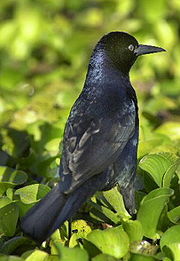
The Icterids are a group of small to medium, often colorful, passerines restricted to the New World, including the grackles, New World blackbirds, and New World orioles. Most have black as a predominant plumage color, often enlivened by yellow, orange or red. There are 98 species worldwide, 57 in North America and 18 in Florida.
- BobolinkBobolinkThe Bobolink is a small New World blackbird and the only member of genus Dolichonyx.-Description:Adults are 16–18 cm long with short finch-like bills. They weigh about . Adult males are mostly black, although they do display creamy napes, and white scapulars, lower backs and rumps...
, Dolichonyx oryzivorus - Red-winged BlackbirdRed-winged BlackbirdThe Red-winged Blackbird is a passerine bird of the family Icteridae found in most of North and much of Central America. It breeds from Alaska and Newfoundland south to Florida, the Gulf of Mexico, Mexico, and Guatemala, with isolated populations in western El Salvador, northwestern Honduras, and...
, Agelaius phoeniceus - Tawny-shouldered BlackbirdTawny-shouldered BlackbirdThe Tawny-shouldered Blackbird is a species of bird in the Icteridae family.It is found in Cuba, the Dominican Republic, Haiti, and the United States....
, Agelaius umeralis (A) - Eastern MeadowlarkEastern MeadowlarkThe Eastern Meadowlark, Sturnella magna, is a medium-sized icterid bird, very similar in appearance to the Western Meadowlark. It occurs from eastern North America to South America, where it is also most widespread in the east.-Description:...
, Sturnella magna - Western MeadowlarkWestern MeadowlarkNot to be confused with Eastern MeadowlarkThe Western Meadowlark is a medium-sized icterid bird, about 8.5 in long. It nests on the ground in open country in western and central North America. It feeds mostly on insects, but also seeds and berries...
, Sturnella neglecta (A) - Yellow-headed BlackbirdYellow-headed BlackbirdThe Yellow-headed Blackbird is a medium-sized blackbird, and the only member of the genus Xanthocephalus....
, Xanthocephalus xanthocephalus - Rusty BlackbirdRusty BlackbirdThe Rusty Blackbird, Euphagus carolinus, is a medium-sized blackbird, closely related to grackles .-Appearance:...
, Euphagus carolinus - Brewer's BlackbirdBrewer's BlackbirdThe Brewer's Blackbird is a medium-sized New World blackbird, named after the ornithologist Thomas Mayo Brewer....
, Euphagus cyanocephalus - Common GrackleCommon GrackleThe Common Grackle, Quiscalus quiscula, is a large icterid.-Description:The long adult has a long dark bill, pale yellowish eyes and a long tail; its feathers appear black with purple, green or blue iridescence on the head, and primarily bronze shine in the body plumage...
, Quiscalus quiscula - Boat-tailed GrackleBoat-tailed GrackleThe Boat-tailed Grackle is a passerine bird of the family Icteridae found as a permanent resident on the coasts of the southeastern USA. It is found in coastal saltwater marshes, and, in Florida, also on inland waters. The nest is a well-concealed cup in trees or shrubs near water; three to five...
, Quiscalus major - Shiny CowbirdShiny CowbirdThe Shiny Cowbird, Molothrus bonariensis, is a passerine bird in the New World family Icteridae. It breeds in most of South America apart from the most dense jungles, mountains and deserts , the coldest southernmost regions , and on Trinidad and Tobago...
, Molothrus bonariensis - Bronzed CowbirdBronzed CowbirdThe Bronzed Cowbird , Molothrus aeneus, is a small icterid.It breeds from the southern U.S. states of California, Arizona, New Mexico, Texas, and Louisiana south through Central America to Panama. An isolated population on the Caribbean coast of Colombia is sometimes treated as a separate species,...
, Molothrus aeneus - Brown-headed CowbirdBrown-headed CowbirdThe Brown-headed Cowbird is a small brood parasitic icterid of temperate to subtropical North America. They are permanent residents in the southern parts of their range; northern birds migrate to the southern United States and Mexico in winter, returning to their summer habitat around March or...
, Molothrus ater - Orchard OrioleOrchard OrioleThe Orchard Oriole, Icterus spurius, is the smallest North American species of icterid blackbird. The subspecies of the Caribbean coast of Mexico, I. s. fuertesi, is sometimes considered a separate species, the Ochre Oriole....
, Icterus spurius - Hooded OrioleHooded OrioleThe Hooded Oriole, Icterus cucullatus, is a medium-sized New World oriole.Adults have a pointed bill and white wing bars. The adult male has an orange head with black on the face and throat; they are black on the back, wings and tail, orange on the underparts...
, Icterus cucullatus (A) - Bullock's OrioleBullock's OrioleThe Bullock's Oriole, , is a small New World blackbird. At one time, this species and the Baltimore Oriole were considered to be a single species, the Northern Oriole...
, Icterus bullockii (A) - Spot-breasted OrioleSpot-breasted OrioleThe Spot-breasted Oriole is a species of bird in the Icteridae family.It is found in Costa Rica, El Salvador, Guatemala, Honduras, Mexico, Nicaragua, and the United States....
, Icterus pectoralis (I) - Baltimore OrioleBaltimore OrioleThe Baltimore Oriole is a small icterid blackbird that averages 18 cm long and weighs 34 g. This bird received its name from the fact that the male's colors resemble those on the coat-of-arms of Lord Baltimore...
, Icterus galbula
Fringilline finches, Cardueline finches, and allies
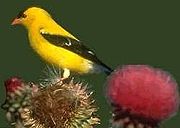
Finches are seed-eating passerines. They are small to moderately large and have strong, usually conical and sometimes very large, beaks. All have 12 tail feathers and nine primaries. They have a bouncing flight with alternating bouts of flapping and gliding on closed wings, and most sing well. There are 137 species worldwide, 81 in North America and six in Florida.
- Purple FinchPurple FinchThe Purple Finch, Carpodacus purpureus, is a bird in the finch family Fringillidae.-Taxonomy:The Purple Finch is one of 24 birds in the genus Carpodacus and is included in the finch...
, Carpodacus purpureus - House FinchHouse FinchThe House Finch is a bird in the finch family Fringillidae, which is found in North America. This species and the other "American rosefinches" are usually placed in the rosefinch genus Carpodacus...
, Carpodacus mexicanus (I) - Red Crossbill, Loxia curvirostra (A)
- Pine SiskinPine SiskinThe Pine Siskin is a North American bird in the finch family. It is a migratory bird with an extremely sporadic winter range.-Description:...
, Carduelis pinus - American GoldfinchAmerican GoldfinchThe American Goldfinch , also known as the Eastern Goldfinch and Wild Canary, is a small North American bird in the finch family...
, Carduelis tristis - Evening GrosbeakEvening GrosbeakThe Evening Grosbeak is a large finch. In the past, it was treated in a genus of its own as Hesperiphona vespertina, but is now usually placed in the same genus as the Hawfinch of Eurasia....
, Coccothraustes vespertinus
Old World sparrows

Old World sparrows are small passerine birds. In general, sparrows tend to be small plump brownish or greyish birds with short tails and short powerful beaks. Sparrows are seed-eaters, and they also consume small insects. There are 35 species worldwide, two in North America and one in Florida.
- House SparrowHouse SparrowThe House Sparrow is a bird of the sparrow family Passeridae, found in most parts of the world. One of about 25 species in the genus Passer, the House Sparrow occurs naturally in most of Europe, the Mediterranean region, and much of Asia...
, Passer domesticus (I)
Uncertain origin
The following species have been reviewed by the FOSRC and, while confirmed in identification, there is uncertainty as to whether they represent escaped individuals or genuine vagrants from established populations.- Trumpeter SwanTrumpeter SwanThe Trumpeter Swan, Cygnus buccinator, is the largest native North American bird, if measured in terms of weight and length, and is the largest living waterfowl species on earth. It is the North American counterpart of the European Whooper Swan.-Description:Males typically measure from and weigh...
Cygnus buccinator (A) - Red-legged HoneycreeperRed-legged HoneycreeperThe Red-legged Honeycreeper is a small songbird species in the tanager family . It is found in the tropical New World from southern Mexico south to Peru, Bolivia and central Brazil, Trinidad and Tobago, and on Cuba, where possibly introduced.-Description:The Red-legged Honeycreeper is on average...
Cyanerpes cyaneus (A)
Notable exotics
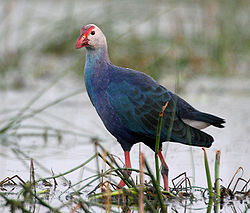
- Mandarin DuckMandarin DuckThe Mandarin Duck , or just Mandarin, is a medium-sized perching duck, closely related to the North American Wood Duck. It is 41–49 cm long with a 65–75 cm wingspan.-Description:...
, Aix galericulata (I) - Egyptian GooseEgyptian GooseThe Egyptian Goose is a member of the duck, goose and swan family Anatidae. It is in the shelduck subfamily Tadorninae, and is the only extant member of the genus Alopochen...
, Alopochen aegyptiaca (I) - Red JunglefowlRed JunglefowlThe Red Junglefowl is a tropical member of the Pheasant family. They are thought to be ancestors of the domestic chicken with some hybridisation with the Grey Junglefowl...
, Gallus gallus (I - Key West) - Common PeafowlIndian PeafowlThe Indian Peafowl or Blue Peafowl is a large and brightly coloured bird of the pheasant family native to South Asia, but introduced and semi-feral in many other parts of the world...
, Pavo cristatus (I) - Purple SwamphenPurple SwamphenThe Purple Swamphen , also known as the African Purple Swamphen, Purple Moorhen, Purple Gallinule, Pūkeko or Purple Coot, is a large bird in the family Rallidae . From its name in French, talève sultane, it is also known as the Sultana Bird...
, Porphyrio porphyrio (I)
See also
- List of North American birds
- List of invasive species in the Everglades#Birds
- Reptiles of FloridaReptiles of FloridaThis is a list of reptiles which are found in the U.S. state of Florida. This list includes both native and introduced species. Introduced species are put on this list only if they have an established population . Three out of the four orders of reptiles can be found in Florida, with the Tuatara...

